- 1在Linux系统上安装Wine方法教程_linuxxiezaiwine教程
- 2linux文件移出目录命令_linux下如何删除整个文件夹及目录命令
- 3Spring Boot集成Kafka详解_spring boot 集成kafaka
- 4MATLAB中安装YALMIP及CPLEX详细步骤_yalmip安装
- 5OpenCV-Python Tutorials - 4.9.4. 轮廓:更多函数_opencv-python-tutorials#4.9.4. 轮廓
- 6SOPC之NiosⅡ系统(三)_niosii 串口
- 7python实例:利用jieba库,分析统计金庸名著《倚天屠龙记》中人物名出现次数并排序...
- 8.NET8杀疯了!微软:比.NET7超级快更快!
- 9训练ChatGPT的必备资源:语料、模型和代码库完全指南_如何训练chartgpt 体制内写材料
- 10图文解读:推荐算法架构——精排!
unity2018.4.3_介绍Unity 2018.3
赞
踩
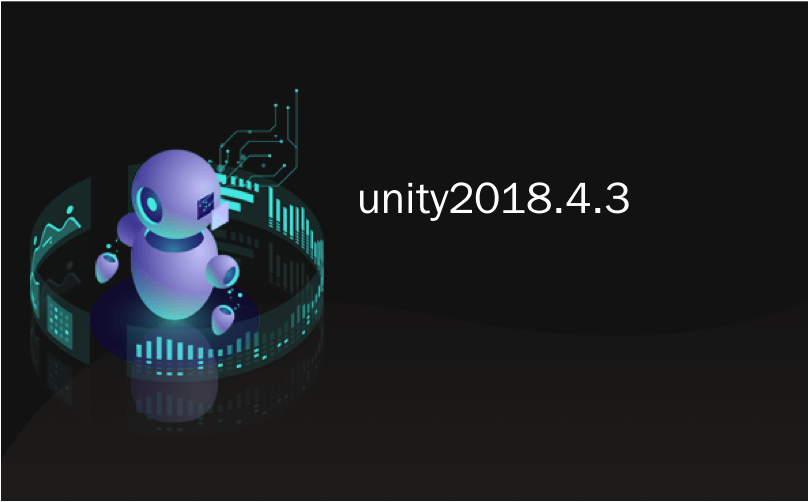
unity2018.4.3
Unity 2018.3 introduces improved Prefab workflows, including nesting, as well as enhancements to our Scriptable Render Pipeline, Terrain system and scripting runtime, and a preview of the Visual Effect Graph.
Unity 2018.3引入了改进的Prefab工作流程,包括嵌套以及对我们的可脚本渲染管道,地形系统和脚本运行时的增强以及视觉效果图的预览。
Over the years, one of the features we’ve heard you requesting most often has been the ability to nest Prefabs. After conducting numerous interviews, usability tests and research at game jams, however, we found out that a lot of you also needed several other changes to the Prefab workflows. Therefore, we have been improving the whole system with a focus on reusability, control and user-friendliness.
多年来,我们最常听到的功能之一就是 嵌套Prefabs的功能 。 在进行了无数次采访,可用性测试和游戏果酱研究之后,我们发现很多人还需要对Prefab工作流程进行其他一些更改。 因此,我们一直在改进整个系统,重点是可重用性,控制性和用户友好性。
The new Prefab workflows allow you to split up scenes and Prefabs on a granular level. They give you greater flexibility, increase your productivity and enable you to work confidently without worrying about making time-consuming errors.
新的Prefab工作流程使您可以精细地分割场景和Prefab。 它们为您提供了更大的灵活性,提高了生产率,并使您可以放心地工作,而不必担心犯费时的错误。
Continuing our focus on workflow improvements, Unity 2018.3 now has unified Settings windows for Project Settings and Preferences. The new windows are dockable and searchable, which makes it much more convenient to quickly find and change settings.
继续致力于改进工作流程,Unity 2018.3现在具有 用于“项目设置”和“首选项”的 统一 “设置”窗口 。 新的窗口是可停靠和可搜索的,这使得快速查找和更改设置更加方便。
The default scripting runtime is now .NET 4.x. The old .NET 3.5 runtime has been deprecated and support for it will soon be dropped. Projects that target the .NET 4.x scripting runtime will be able to use the open-source Roslyn compiler.
现在,默认脚本运行时为 .NET4.x 。 旧的.NET 3.5运行时已过时,对此的支持将很快删除。 面向.NET 4.x脚本运行时的项目将能够使用开源 Roslyn编译器 。
In this release, we also added a PhysX 3.4 upgrade that comes with improvements to stability and performance as well as support for multiple worlds and C# Job queries.
在此版本中,我们还添加了 PhysX 3.4 升级,它改进了稳定性和性能,并支持多个世界和 C#Job查询。
The world-building 2D Tilemap tool now enables you to build isometric Tilemaps, which makes it easier to create 2D projects such as strategy, tycoons and simulation games.
现在,世界一流的2D Tilemap工具使您能够构建 等距的Tilemaps ,这使创建2D项目(例如策略,大亨和模拟游戏)更加容易。
Unity 2018.3 also ships with an update to the Terrain system, which marks the beginning of a larger overhaul. In this update, our focus has been not only to set the foundation for further improvements with a few tweaks to the UI and tools but also to improve performance. We also added High-Definition Render Pipeline (HDRP) and Lightweight Render Pipeline (LWRP) support.
Unity 2018.3还随附了 Terrain系统 的更新 , 这标志着大修的开始。 在此更新中,我们的重点不仅是通过对UI和工具的一些调整为进一步改进奠定基础,而且还旨在提高性能。 我们还添加了高清渲染管道(HDRP)和轻型渲染管道(LWRP)支持。
Unity 2018.3 includes a number of improvements to the HDRP (preview). This version adds preliminary support for VR and multisample anti-aliasing and improves support for PC, Mac, XBox One and PS4. The UI of various Inspectors of HDRP elements is now updated: Camera, Lights, Reflections Probe, and Material. Finally, we added a new lighting model, so you can author more complex materials.
Unity 2018.3对 HDRP (预览版)进行 了许多改进 。 此版本增加了对VR和多样本抗锯齿的初步支持,并改进了对PC,Mac,XBox One和PS4的支持。 HDRP元素的各种检查器的UI现在已更新:相机,光源,反射探针和材质。 最后,我们添加了一个新的照明模型,因此您可以创作更复杂的材料。
We are also introducing the GPU Progressive Lightmapper in Preview for Windows and several improvements to lighting.
我们还将在Windows预览版中引入GPU渐进式光照贴图器 ,并对照明进行一些改进。
Our new Visual Effect Graph, which ships in Preview as a package, enables you to create beautiful effects using a node-based system that is both easy to use and flexible. Inspired by leading VFX software tools for films, it empowers artists to create stand-out visual effects for games and other projects with millions of particles running on the GPU.
我们新的 视觉效果图 , 其中船舶在预览作为一个包,使您可以创建使用基于节点的系统,既易于使用和灵活的漂亮的效果。 受领先的电影VFX软件工具的启发,它使艺术家能够在GPU上运行数百万个粒子的情况下,为游戏和其他项目创建出色的视觉效果。
Unity 2018.3 also includes several new features for the existing Particle System. For example, there are Particle Meshes that can now be flipped just like with billboards, Particle Lights that now support Real-time Global Illumination, and the new Ringbuffer Mode, which makes it easier to create persistent effects like footprints or bullet holes by keeping particles visible after their lifetime expires and until they are replaced.
Unity 2018.3还为现有的 粒子系统 提供了一些新功能 。 例如,现在可以像广告牌一样翻转“粒子网格”,现在支持实时全局照明的“粒子灯”,以及新的“环形缓冲”模式,通过保留粒子,可以更轻松地创建持久性效果,例如覆盖区或弹Kong在它们的生命周期到期后直到被替换之前可见。
Mobile improvements include Dynamic Resolution Scaling support for Vulkan and Metal, Android AppBundle generation support and faster APK package build times on Android with APKzlib.
移动 方面的改进包括对Vulkan和Metal的动态分辨率缩放支持,Android AppBundle生成支持以及使用APKzlib在Android上更快的APK包构建时间。
For XR, we added Native Support for Daydream Controllers, Haptics APIs for VR controllers, and updates to the AR Foundation as well as XR Performance Testing.
对于 XR, 我们添加了对Daydream控制器的本机支持,用于VR控制器的Haptics API,对AR Foundation的更新以及XR性能测试。
And in our Developer services, we added several improvements to Collaborate and Cloud Build. Performance Reporting, renamed Cloud Diagnostics, now also tracks user-submitted reports.
在 开发人员服务中 , 我们对协作和云构建进行了一些改进。 现在 ,性能报告(已 重命名为Cloud Diagnostics )也可以跟踪用户提交的报告。
Finally, 2018.3 comes with a number of smaller changes and bug fixes. You can begin downloading the full release from our update page or through your Unity Hub before digging into all the details.
最后,2018.3附带了一些较小的更改和错误修复。 在深入研究所有细节之前, 您可以从我们的 更新页面 或通过Unity Hub 开始下载完整版本 。
告诉我所有细节 (Show me all the details)
编辑器和工作流程 (Editor & workflows)
嵌套式预制件和改进的预制件工作流程 (Nested Prefabs and improved Prefab workflows)
One of the top-requested additions to Unity is the ability to nest Prefabs. But from the numerous interviews, several usability tests, surveys of more than 150 customers, and two game jams we’ve done with a wide range of indie and AAA studios, we know a lot of you also needed several other changes to the Prefab workflows. Therefore, we have been improving the whole system with a focus on reusability, control, and safety. The long-term goal has been not only to implement support for nesting but to rethink the core Prefab workflows so different team members can simultaneously edit Prefabs confidently and efficiently.
需求最大的Unity附加功能之一是嵌套Prefabs的功能。 但是从众多采访,几次可用性测试,对150多家客户的调查以及我们与众多独立和AAA工作室所做的两次游戏卡纸中,我们知道很多人还需要对Prefab工作流程进行其他一些更改。 因此,我们一直在改进整个系统,重点是可重用性,控制性和安全性。 长期目标不仅是实现对嵌套的支持,而且是重新考虑核心Prefab工作流,以便不同的团队成员可以自信而高效地同时编辑Prefab。
The new Prefab workflows allow you to split up scenes and Prefabs on a granular level. They give you greater flexibility, increase your productivity and enable you to work confidently without worrying about making time-consuming errors.
新的Prefab工作流程使您可以精细地分割场景和Prefab。 它们为您提供了更大的灵活性,提高了生产率,并使您可以放心地工作,而不必担心犯费时的错误。
套料 (Nesting)
Greater flexibility
更大的灵活性
Previously, you were forced to choose between creating large monolithic Prefabs, like buildings, or more granular ones, like pieces of furniture, but you couldn’t do both. Now with support for nested Prefabs, a large building can comprise many smaller room Prefabs, which in turn can comprise multiple pieces of furniture Prefabs, and so on.
以前,您被迫在创建大型整体式预制件(如建筑物)或更细化的预制件(如家具)之间进行选择,但您不能两者都做。 现在,在支持嵌套式预制件的情况下,大型建筑物可以包括许多较小的房间预制件,而这些房间又可以包括多个家具预制件,依此类推。
We have implemented a backward compatible Prefab backend that now supports nesting and inheritance.
我们已经实现了向后兼容的Prefab后端,该后端现在支持嵌套和继承。
This makes it easier for teams of all sizes to:
这使各种规模的团队都更容易:
Split up Prefabs into multiple entities for greater efficiency
将预制件拆分为多个实体,以提高效率
Reuse any content, from small to large
重用任何内容,从小到大
Work on different parts of content simultaneously
同时处理内容的不同部分
预制变体 (Prefab Variants)
Flexible properties increase efficiency
灵活的性能提高效率
As a default, a Prefab Variant inherits the objects and properties of the Prefab it is a variant of, but at the same time, you can both override those properties and add additional components and GameObjects. This is similar to the concept of inheritance in object-oriented programming.
默认情况下,Prefab Variant会继承它的Prefab的对象和属性,但是同时,您可以覆盖这些属性并添加其他组件和GameObjects。 这类似于面向对象编程中的继承概念。
For example, if you have a door Prefab, you can create a Variant of it and assign it a different mesh and material to make it look old and broken. Any changes made to the base door Prefab will affect the Variant, allowing you to easily tweak the size of the Collider for both doors by changing the base.
例如,如果您有门预制件,则可以为其创建变体,并为其分配不同的网格和材料,以使其看起来既旧又破。 对基础门Prefab进行的任何更改都会影响Variant,从而使您可以通过更改基础轻松调整两个门对撞机的尺寸。
We have also improved the visualization of property and object overrides for Prefab instances, and added the ability to apply overrides on multiple levels of granularity: per property, per Component/GameObject, or, as before, the entire Prefab instance.
我们还改善了Prefab实例的属性和对象替代的可视化,并增加了在多个粒度级别上应用替代的功能:每个属性,每个Component / GameObject或像以前一样整个Prefab实例。
预制模式 (Prefab Mode )
Avoid time-consuming mistakes
避免费时的错误
An issue we found was that when you wanted to edit a Prefab Asset, you had to drag it to an open scene in the Hierarchy to modify it, apply the changes, and then remember to delete it again. Another big issue was the Apply button for Prefab instances in the Inspector. With this button, you could accidentally apply changes to the Prefab Asset, and you had no easy way of seeing an overview of what you were changing. We solved this by introducing the new Prefab Mode, which enables you to edit Prefabs in isolation.
我们发现的一个问题是,当您要编辑“预制资产”时,必须将其拖动到“层次结构”中的开放场景中以对其进行修改,应用更改,然后记住再次将其删除。 另一个大问题是Inspector中Prefab实例的Apply按钮。 使用此按钮,您可能会意外地将更改应用于“预制资产”,并且没有简便的方法查看更改的概述。 我们通过引入新的预制模式解决了这一问题,该模式使您可以单独编辑预制。
Being able to edit an entire Prefab Asset without having to instantiate it in the scene or edit an existing instance means you can avoid mistakes related to accidentally applying overrides in the scene. By being able to edit instances and assets separately, you can make your changes with confidence.
能够编辑整个Prefab Asset而不需要在场景中实例化它或编辑现有实例,意味着您可以避免与意外在场景中应用替代有关的错误。 通过能够分别编辑实例和资产,您可以放心地进行更改。
Learn how the Unity R&D team’s Nikoline Høgh and Stine Kjærbøll went on a journey of discovery: Running user tests, conducting surveys and talking face-to-face with 150 customers, they gained valuable insight that has helped fundamentally improve the Prefab workflows.
了解Unity R&D团队的NikolineHøgh和StineKjærbøll如何进行探索之旅:运行用户测试,进行调查并与150个客户面对面交谈,他们获得了宝贵的见解,从根本上改善了Prefab的工作流程。
Sample project to help you get started
示例项目可帮助您入门
We added a collection of examples for learning how to use the new improved Prefab workflows, which are available here. Let us know what you think by sharing information about the new Prefab workflows on our forum.
我们添加了一系列示例,以学习如何使用新的改进的Prefab工作流程, 可在此处获得。 通过在 论坛 上共享有关新的Prefab工作流程的信息,让我们知道您的想法 。
用户首选项和设置窗口 (User preferences & settings windows)
In 2018.3, we added new windows to give you a consistent and efficient way to find and manage all User Preferences and Project Settings. The windows are dockable with easy left-to-right navigation, and you can search through all the settings to quickly find what you’re looking for.
在2018.3中,我们添加了新窗口,为您提供了一种一致且有效的方式来查找和管理所有用户首选项和项目设置。 窗口可停靠,易于左右导航,您可以搜索所有设置以快速找到所需内容。
The windows also come with an API so you can easily add your own settings for your Package or Asset Store plugin.
这些窗口还带有API,因此您可以轻松地为Package或Asset Store插件添加自己的设置。
Usability improvements
可用性改进
It is now also easier for you to work with window tabs. The selected window tab is highlighted with a blue outline and the width of the tab is adjusted according to the length of the tab title. When the number of open tabs exceeds the width of the window, you can scroll through the windows using the arrow keys.
现在,您还可以更轻松地使用窗口选项卡。 选定的窗口选项卡以蓝色轮廓突出显示,并且选项卡的宽度根据选项卡标题的长度进行调整。 当打开的选项卡数超过窗口的宽度时,您可以使用箭头键在窗口中滚动。
电影学 (Cinematics)
时间线 (Timeline)
In 2018.3 significant improvements have been made to how Timeline Animation Tracks handle animations on the root transform of a hierarchy.
在2018.3中,``时间轴动画轨迹''在层次结构根转换上处理动画的方式已进行了重大改进。
New Track Offset Modes
新的音轨偏移模式
These modes accurately indicate in Timeline where in the scene a character should start animating from. In pre-2018.3 versions of Timeline, the starting position was dependent on the animator state. The track now provides you with additional options with Auto mode for backward compatibility.
这些模式可以在时间轴中准确指示角色应该从何处开始进行动画制作。 在时间轴2018.3之前的版本中,起始位置取决于动画师的状态。 现在,该曲目为您提供了自动模式的其他选项,以实现向后兼容。

Adapts to Scale
适应规模
Timeline now applies local scale to the animations on the Root Transform if the Apply Root Motion flag on the animator is set. This makes Timeline assets even more reusable between different GameObjects, and helps remove foot-sliding and other unwanted artifacts.
现在,如果在动画器上设置了“应用根运动”标志,则时间轴现在会将局部比例应用于“根变换”上的动画。 这使得时间轴资产在不同的GameObject之间更加可重用,并有助于消除滑脚和其他不需要的伪像。
Root Motion No Longer Required
不再需要根运动
Prior to 2018.3, for clips that animated root transform position and rotation, the animation clip required Root Motion Curves to be generated for any root transformation to apply. This is no longer required, meaning all clips that animated position and rotation will work with Timeline, with the exception of legacy clips.
在2018.3之前,对于动画化根变换位置和旋转的剪辑,该动画剪辑需要生成``根运动曲线''才能应用任何根变换。 不再需要此功能,这意味着所有具有动画位置和旋转效果的片段都可以与时间轴一起使用,但旧有片段除外。
Improved Editor Preview
改进的编辑器预览
We’ve improved in-editor Timeline previews. When using Scene Offsets, the scene position is used as an offset. Applying ease-in/ease-out will blend to the scene pose and scene position.
我们改进了编辑器中的时间轴预览。 使用场景偏移时,场景位置用作偏移。 应用缓入/缓出将融合到场景姿势和场景位置。
电影机 (Cinemachine)
We also added Physical camera support for Cinemachine, an Event mapper and a new procedural noise editor with an interactive display.
我们还增加了对Cinemachine的物理摄像机支持,事件映射器和带有交互式显示器的新程序噪声编辑器。
Change the physical feel of Cinemachine cameras with the visual noise editor.
使用可视噪声编辑器更改Cinemachine摄像机的物理感觉。

世界建设 (Worldbuilding)
The ProBuilder 3D modeling and level design tools became a part of Unity earlier this year, and version 4.0 now brings a major update. It focuses on stability and bug fixes but also includes several new features and important changes.
ProBuilder 3D建模和关卡设计工具于今年早些时候成为Unity的一部分,而4.0版现在进行了重大更新。 它着重于稳定性和错误修复,还包括一些新功能和重要更改。
Most importantly, ProBuilder 4.0 is now distributed as source code, and introduces a new- improved public API, giving developers many more options for customization in the Editor and at runtime. The update also adds support for the new Nested Prefab workflows, performance improvements, and visual upgrades, such as pre-selection highlights for all element selections. Get more info about ProBuilder 4.0 in this forum thread.
最重要的是,ProBuilder 4.0现在作为源代码发布,并引入了一个经过改进的公共API,从而为开发人员提供了更多的选项,可在编辑器中和运行时进行自定义。 此更新还增加了对新的嵌套式预制工作流程,性能改进和视觉升级的支持,例如所有元素选择的预选突出显示。 在此论坛主题中获取有关ProBuilder 4.0的更多信息。
地形更新 (Terrain updates)
Unity 2018.3 includes an update to the Terrain system with a focus on performance and usability.
Unity 2018.3包括对Terrain系统的更新,重点是性能和可用性。
It features improved tools and performance that take better advantage of the GPU. It also adds support for the HDRP and LWRP pipelines, while being backward compatible with the built-in render pipeline and the existing Unity Terrain system.
它具有改进的工具和性能,可以更好地利用GPU。 它也增加了对HDRP和LWRP管道的支持,同时与内置渲染管道和现有的Unity Terrain系统向后兼容。
性能 (Performance)
On the performance side, we added a GPU-instanced render path for Terrain. In most cases, instancing yields a dramatic reduction in the number of draw calls issued. Many of our tests saw more than a 50% reduction in CPU costs (though, of course, actual numbers will depend on your platform and use case).
在性能方面,我们为Terrain添加了GPU实例化的渲染路径。 在大多数情况下,实例化可大大减少发出的抽签数量。 我们的许多测试都将CPU成本降低了50%以上(不过,当然,实际数字将取决于您的平台和用例)。
可编写脚本的GPU工具 (Scriptable GPU tools)
On the Editor side, we have exposed a script API for building your own custom Terrain tools, along with a suite of utility functions you can use to easily implement seamless cross-tile sculpting and painting operations on the GPU.
在编辑器端,我们公开了用于构建自己的自定义Terrain工具的脚本API,以及可用于轻松在GPU上实现无缝的交叉拼贴雕刻和绘画操作的一组实用程序功能。
We also converted all of the existing Terrain tools to GPU operations. Aside from making these tools much faster, this also gave us larger brush sizes, improved brush previews, and the ability to paint across Terrain tile borders with automatic seam-stitching.
我们还将所有现有的Terrain工具都转换为GPU操作。 除了使这些工具更快之外,这还为我们提供了更大的笔刷大小,更佳的笔刷预览效果,以及能够通过自动缝线缝合在Terrain瓷砖边框上进行绘制的功能。
多地形支持 (Multiple Terrain support)
We made it easier to work with multiple Terrain tiles. In addition to seamless painting between Terrain, you can now manage the connections between neighboring Terrain automatically. Previously, this required writing a script to connect neighbors manually.
我们简化了使用多个地形图块的工作。 除了在Terrain之间进行无缝绘制外,您现在还可以自动管理相邻Terrain之间的连接。 以前,这需要编写脚本来手动连接邻居。
When expanding your existing Terrain, you can use our new Create Neighbor Terrain tool to quickly add matching Terrain tiles along empty borders.
扩展现有地形时,可以使用我们新的“创建邻居地形”工具沿空边框快速添加匹配的地形图块。
新资产类型和工具 (New Asset types and tools)
New Terrain tools and Brush Assets include heightmap, mesh stamping and clone brushes. These painting tools are currently not in 2018.3, but you can get them via our GitHub Terrain Tools project.
新的地形工具和画笔资源包括高度图,网格图章和克隆画笔。 这些绘画工具当前不在2018.3中 ,但是您可以通过我们的 GitHub Terrain Tools项目 获得它们 。
There are also two new Terrain-related Asset types that will simplify your workflow: the TerrainLayer Asset and the Brush Asset. TerrainLayer lets you define Terrain materials independent of the Terrain object so that you can easily track the same material across multiple Terrain objects. This helps you paint seamlessly, and makes it easier to modify materials.
还有两种与地形相关的新资产类型可以简化您的工作流程:TerrainLayer资产和笔刷资产。 TerrainLayer允许您独立于Terrain对象定义Terrain材质,以便您可以轻松地跨多个Terrain对象跟踪同一材质。 这可以帮助您无缝地进行绘制,并使修改材料变得更加容易 。
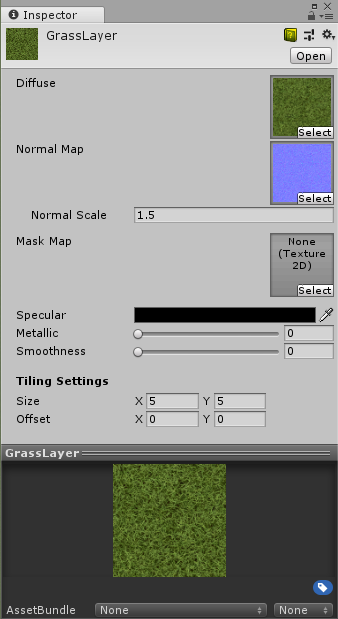
The Brush represents the GPU brush shapes used by painting and sculpting tools. They are now defined by a texture and a radial falloff curve, which makes it much easier to create and tweak brush shapes.
画笔代表绘画和雕刻工具使用的GPU画笔形状。 现在,它们由纹理和径向衰减曲线定义,这使得创建和调整画笔形状变得更加容易。
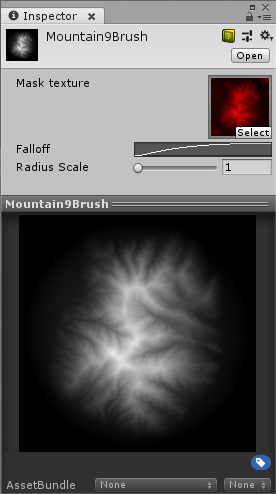
We also added support for the R16 texture format (a single-channel 16-bit format). This allows us to avoid 8-bit quantization on our brush shapes, which can cause undesirable ‘terracing’ effects if used as a heightmap stamp.
我们还添加了对R16纹理格式(单通道16位格式)的支持。 这样可以避免对笔刷形状进行8位量化,如果将其用作高度图标记,可能会导致不良的“梯形”效果。
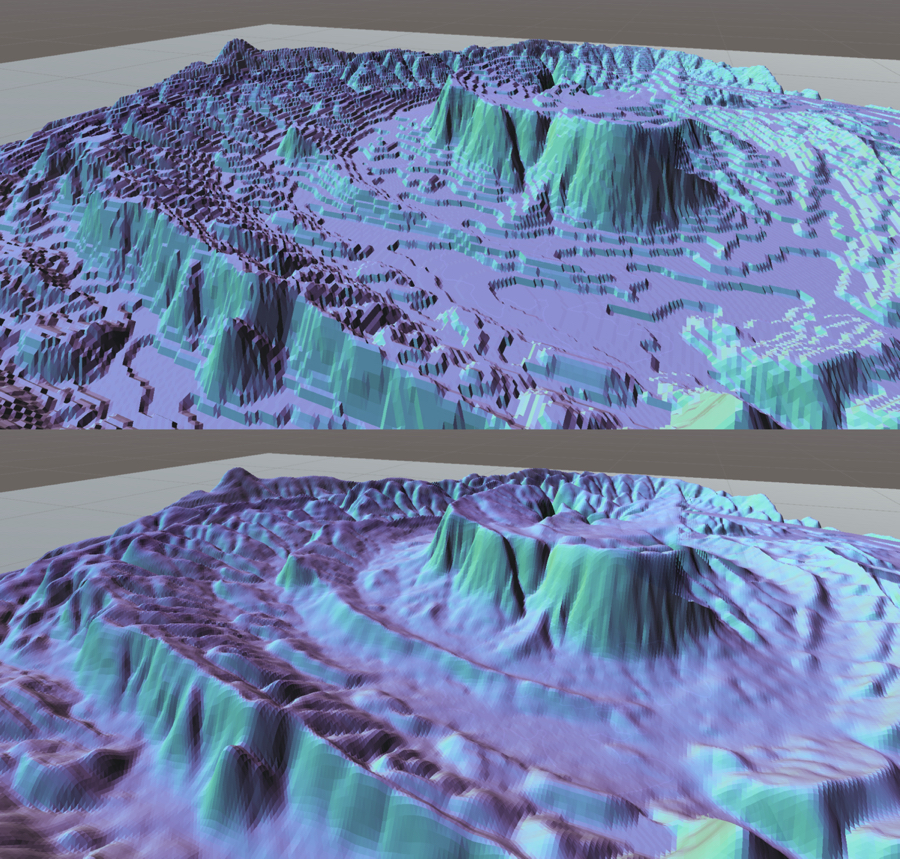
8-bit brush stamp showing ‘terracing’ artifacts (top) and 16-bit brush stamp (bottom).
显示“梯形”伪像的8位笔刷图章(顶部)和16位笔刷图章(底部)。
Please send us feedback in the World Building forum!
请在 世界建筑 论坛上 向我们发送反馈 !
软件包管理器更新 (Package Manager updates)
The Package Manager gives you quick access to new Unity features by dynamically loading and updating Unity-developed features for your various projects.
该 软件包管理器 让您快速访问到新的团结,通过动态加载和更新统一开发的功能,为您的各种项目的特点。
As more Unity features move into the Package format, we are steadily improving the user experience (UX) to make it easier for you to discover available packages and updates, and to manage the Packages installed in your projects.
随着越来越多的Unity功能变为 Package格式 ,我们正在稳步改善用户体验(UX),使您更容易发现可用的包和更新,以及管理项目中安装的Packages。
We added a large number of improvements to the Package Manager, including a better UI, which indicates the status of package labels, the ability to dock the window and easy access to both the documentation and a list of the changes. You can now also search for packages by name, and we are introducing some of the first UX building blocks that will enable you to manually add your own custom-built packages. You can see more of the latest developments and join the discussion on our Package Manager forum.
我们对“程序包管理器”进行了大量改进,包括更好的UI,该程序可以指示程序包标签的状态,停靠窗口的功能以及对文档和更改列表的轻松访问。 现在,您还可以按名称搜索软件包,我们将介绍一些第一个UX构建块,使您可以手动添加自己的定制软件包。 您可以查看更多最新动态,并在我们的Package Manager 论坛中 加入讨论 。
更新集线器 (Updates to the Hub)
Back in September, we launched the Unity Hub 1.0, our new connected desktop app designed to streamline onboarding and production processes by offering a central place for managing your Unity projects, licenses, Editor installations and add-on components. The new Hub v1.2 release includes the ability to download and install the legacy Unity Editor builds directly in the Hub via the Unity download archive URLs. Users who depend on specific (older) versions of the Editor for their projects can now easily access them from the Hub with one click.
早在9月,我们就推出了 Unity Hub 1.0 ,这是我们的新连接桌面应用程序,旨在通过提供一个集中位置来管理Unity项目,许可证,编辑器安装和附加组件来简化入门和生产流程。 新的Hub v1.2版本具有通过 Unity下载档案 URL 直接在Hub中下载和安装旧版Unity Editor构建的功能 。 现在,依靠特定(较旧)版本的Editor进行项目的用户可以轻松地从Hub上一键访问它们。

As more features and updates are distributed as Packages, the new Package Project Updater will help streamline the upgrade process via the Hub. This helps ensure that your project packages, scripts and Project library are compatible when migrating projects from a prior Unity release to a newer version.
随着更多功能和更新作为程序包分发,新的 程序包项目更新程序 将通过集线器帮助简化升级过程。 这有助于确保在将项目从Unity先前版本迁移到较新版本时,项目包,脚本和项目库兼容。
A Package Update log file is also provided to help with debugging, so you can keep track of the migration status on each affected project level.
还提供了软件包更新日志文件来帮助调试,因此您可以在每个受影响的项目级别上跟踪迁移状态。
引擎更新 (Engine updates)
用于Unity扩展的Visual Studio代码调试器 (Visual Studio Code Debugger for Unity extension)
We’ve updated the debugger extension for Visual Studio Code, an open-source, code-optimized editor available on macOS, Windows, and Linux. The Debugger for Unity extension provides debugging support for C# scripts in a lightweight environment, and the latest 2.x version adds various improvements, including support for the Mono 4.x scripting runtime. To get started, follow the setup instructions on the Visual Studio Code site.
我们已经更新了 Visual Studio Code 的调试器扩展, Visual Studio Code 是在macOS,Windows和Linux上可用的,经过代码优化的开源编辑器。 在 调试器统一扩展 提供的调试C#脚本的支持在一个轻量级的环境,最新的2.x版增加了各种改进,包括单声道4.x的脚本运行时支持。 首先,请按照 Visual Studio Code网站上的 安装说明 进行 操作 。
If you’re looking for a more integrated and feature-rich C# editing and debugging environment, there’s also Visual Studio and Visual Studio for Mac. Check out this documentation to get started.
如果您正在寻找更集成且功能更丰富的C#编辑和调试环境,则还可以使用Visual Studio和Visual Studio for Mac。 查看此 文档 以开始使用。
物理 (Physics)
PhysX 3.4
PhysX 3.4
In 2018.3, we upgraded from NVIDIA PhysX 3.3 to 3.4. In some cases, the upgrade doubles the speed of operations such as raycasting, shape sweeping and mesh cooking. It also improves support for detecting collisions with fastly rotating objects and adds enhanced determinism ensuring the same simulation result when all the inputs are exactly the same.
在2018.3中,我们从NVIDIA PhysX 3.3升级到了3.4。 在某些情况下,升级将使光线投射,扫形和网状烹饪等操作速度加倍。 它还提高了对检测与快速旋转的对象的碰撞的支持,并增加了确定性,从而在所有输入都完全相同时确保相同的仿真结果。
We are also expanding on what’s available from PhysX in the C# Job System. This allows you to utilize most collider types asynchronously and off the main thread, allowing for significant performance improvements on multi-core hardware. The PhysX 3.4 upgrade also comes with improvements to stability and performance. Finally, there is now support for multiple worlds and C# job queries.
我们还在C#作业系统中扩展PhysX的功能。 这使您可以在主线程之外异步使用大多数对撞机类型,从而在多核硬件上显着提高性能。 PhysX 3.4升级还改善了稳定性和性能。 最后,现在支持多个世界和C#作业查询。
Multi-scene physics
多场景物理
You can now create multiple physics scenes (as opposed to just one scene populated with all the bodies and colliders). This change enables you to specify whether a given Unity scene uses the default physics scene, or needs its own local one for both 2D and 3D physics.
现在,您可以创建多个物理场景(与仅一个由所有物体和对撞机填充的场景相对)。 通过此更改,您可以指定给定的Unity场景是使用默认物理场景,还是需要自己的本地场景用于2D和3D物理。
Learn more about in this blog post on Unity 2018.3 physics.
在 有关Unity 2018.3物理的博客文章中 了解更多信息 。
垃圾收集控制 (Garbage Collection Control)
A new UnityEngine.Scripting.GarbageCollector scripting API has been added for globally enabling and disabling garbage collection at runtime on Mono and IL2CP scripting backends. If you carefully manage your memory and have few or no allocations at runtime, you can avoid garbage collector overhead by disabling it. You can then enable it again when you can afford the overhead and call System.GC.Collect() to force it to collect garbage. Put another way, instead of having garbage collection happen at random times, you can now control when it happens.
添加了 新的 UnityEngine.Scripting.GarbageCollector 脚本API,以便在运行时在Mono和IL2CP脚本后端上全局启用和禁用垃圾收集。 如果您仔细管理内存并在运行时分配很少或没有分配,则可以通过禁用内存来避免垃圾回收器的开销。 然后,当您负担得起开销时,可以再次启用它,并调用System.GC.Collect()强制其收集垃圾。 换句话说,您现在可以控制何时发生垃圾,而不是随机进行垃圾收集。
.NET 4.x等效脚本运行时默认选项 (.NET 4.x Equivalent scripting runtime the default option)
The .NET 4.x Equivalent scripting runtime is now the default option for new Unity projects.
现在,.NET 4.x等效脚本运行时是新Unity项目的默认选项。
The old scripting runtime ( .NET 3.5 Equivalent) has been deprecated and will be removed during the 2019.x release cycle. Both scripting runtime versions will still be supported in the LTS 2018.
旧的脚本运行时( .NET 3.5 Equivalent )已被弃用,并将在2019.x发布周期中删除。 LTS 2018仍将支持两个脚本运行时版本。
If you haven’t tried your project with the new, .NET 4.x Equivalent scripting runtime (introduced in 2018.2), the new features are a great reason to switch such as bringing you full TLS 1.2 support to all of the .NET class library APIs, on all Unity platforms with Mono and IL2CP.
如果您尚未尝试使用新的.NET 4.x等效脚本运行库( 于2018.2引入)来 尝试项目 ,则新功能是切换的重要原因,例如为您提供对所有.NET类的完全TLS 1.2支持所有具有Mono和IL2CP的Unity平台上的库API。

We have worked extensively on reducing the size of your projects. Total build size (on iOS, for example) of a 2018.3 project using new scripting runtime should be very comparable to a 2018.2 or previous build with the old scripting runtime.
我们在减少项目规模方面进行了广泛的工作。 使用新脚本运行时的2018.3项目的总构建大小(例如,在iOS上)应与具有旧脚本运行时的2018.2或先前版本非常相似。
As well, projects that target the .NET 4.x scripting runtime will be able to use the open-source Roslyn compiler, avoiding any bugs present in the previously used Mono C# compiler.
同样,面向.NET 4.x脚本运行时的项目也将能够使用开源Roslyn编译器,从而避免了先前使用的Mono C#编译器中存在的任何错误。
代码大小 (Code Size)
We have standardized managed code-stripping across all platform player settings. The Stripping Level option has been replaced by a new Managed Stripping Level option. This new option is available for all platforms and both Mono and IL2CPP scripting backends.
我们已经在所有平台播放器设置中标准化了托管代码剥离。 剥离级别选项已由新的托管剥离级别选项代替。 此新选项可用于所有平台以及Mono和IL2CPP脚本后端。
To help you make your games as small as possible, we’ve introduced two new Managed Stripping Level options: Medium and High. These new options are only available when targeting the .NET 4.x scripting runtime.
为了帮助您使游戏尽可能小,我们引入了两个新的“托管剥离级别”选项:“中”和“高”。 这些新选项仅在以.NET 4.x脚本运行时为目标时才可用。
With the managed code-stripping improvements and size improvements made to IL2CPP, builds that target the .NET 4.x runtime will be comparable in size to the old .NET 2.0 runtime.
通过对IL2CPP进行托管代码剥离改进和大小改进,针对.NET 4.x运行时的构建的大小将与旧的.NET 2.0运行时相当。
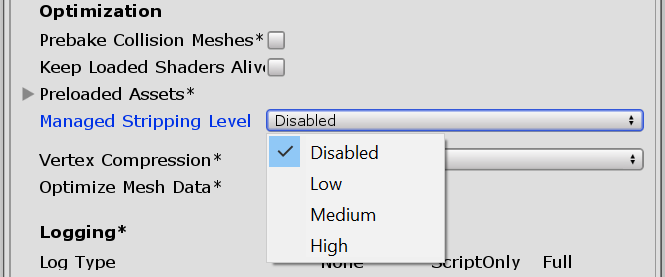
C#7.3 –罗斯林 (C# 7.3 – Roslyn)
C# 7.3 is now supported in projects targeting the .NET 4.x scripting runtime. This is possible because we improved compatibility with the open-source Roslyn C# compiler, bringing the latest C# 7.3 language features and reducing compilation time.
现在,针对.NET 4.x脚本运行时的项目支持C#7.3。 之所以如此,是因为我们提高了与 开源Roslyn C# 编译器的 兼容性 ,带来了最新的C#7.3语言功能并减少了编译时间。
用于重新压缩下载的资产捆绑包的运行时API (Runtime API for recompressing downloaded asset bundles)
AssetBundles are archive files containing platform-specific assets (for example, models, textures, Prefabs, audio clips, and even entire scenes) that can be loaded at runtime. They can reduce the initial install size of downloadable content (DLC), ensure the assets are optimized for the end-user’s platform and reduce runtime memory pressure.
AssetBundle是包含可在运行时加载的特定于平台的资产(例如,模型,纹理,预制,音频剪辑,甚至整个场景)的存档文件。 它们可以减小可下载内容(DLC)的初始安装大小,确保针对最终用户平台优化资产并减轻运行时内存压力。
In 2018.3, we provide an API that allows you to create and manage your own asset-bundle cache system. You will still be able to deliver LZMA-compressed bundles to clients, who can then recompress them to a more runtime-friendly format (LZ4), just as with our native/built-in asset-bundle cache system.
在2018.3中,我们提供了一个API,可让您创建和管理自己的资产捆绑式缓存系统。 您仍然可以将LZMA压缩的捆绑包交付给客户端,然后客户端可以将其重新压缩为对运行时更友好的格式(LZ4),就像我们的本机/内置资产捆绑缓存系统一样。
导航系统更新 (Navigation system updates)
The NavMesh Surface component represents the walkable area for a specific NavMesh Agent type, and defines the part of the scene where a NavMesh should be built. As of 2018.3, the navigation system will enable NavMeshSurfaces in Prefabs to be baked in isolation in Prefab mode. You can now also call the NavMeshQuery.Raycast method in jobs if you want to trace a straight path or find obstructions between two positions on the NavMesh. We are continuously making improvements and would love to get your input in our forum.
NavMesh曲面组件代表特定NavMesh代理类型的可步行区域,并定义应在其中构建NavMesh的场景部分。 从2018.3开始,该导航系统将使Prefabs中的NavMeshSurfaces能够以Prefab模式隔离烘焙。 现在,如果要跟踪直线路径或在NavMesh上两个位置之间找到障碍物,也可以在作业中调用NavMeshQuery.Raycast方法。 我们正在不断改进,并希望在我们的 论坛中 得到您的意见 。
资产上传管道 (Asset Upload Pipeline)
Prior to 2018.3, the AUP only handled textures. In 2018.3, the AUP now loads textures and meshes, but there are some exceptions. Textures that are read/write enabled, or meshes that are read/write enabled or compressed, will not use the AUP. Note that Texture Mipmap Streaming, which was introduced in 2018.2, also uses AUP.
在2018.3之前,AUP仅处理纹理。 在2018.3中,AUP现在会加载纹理和网格,但是有一些例外。 启用了读/写的纹理,或启用了读/写或压缩的网格将不使用AUP。 请注意,2018.2中引入的Texture Mipmap Streaming也使用AUP。
Learn more in our recent blog post
内存探查器 (Memory Profiler)
Memory consumption is a critical performance indicator, which is especially important for platforms with limited memory resources, such as low-end mobile devices.
内存消耗是关键的性能指标,对于内存资源有限的平台(例如低端移动设备)尤其重要。
Although Unity has good performance tools, it has traditionally been lacking in the area of troubleshooting memory-related issues. Finding leaking memory, your largest allocations, or just poking around to see what was happening wasn’t simple.
尽管Unity具有良好的性能工具,但是在解决与内存相关的问题方面传统上一直缺乏。 找到泄漏的内存,最大的分配或者只是四处看看发生了什么都不容易。
With that in mind, we wanted to make it easier for you to understand what’s happening with memory in your project. With the new Memory Profiler, you will be able to dig into the details of every allocation.
考虑到这一点,我们希望使您更容易理解项目中内存的情况。 使用新的Memory Profiler,您将能够深入挖掘每个分配的细节。
You can use it to capture snapshots, break down both native and managed memory usage and, ultimately, make better decisions about optimizing your memory usage. This applies to investigating C# and C++ memory, the relationship between different allocations, internal Unity allocations, and working with low-memory devices.
您可以使用它来捕获快照,分解本机和托管内存使用情况,并最终就优化内存使用情况做出更好的决策。 这适用于调查C#和C ++内存,不同分配之间的关系,内部Unity分配以及使用低内存设备的情况。
Finally, you are also able to compare the difference between snapshots to identify memory leaks. The Memory Profiler is available in its first release as a Preview, and it will be continuously updated. We would love to hear what you think of it. If you are interested in performance optimization, we encourage you to join our profiler forum.
最后,您还可以比较快照之间的差异以识别内存泄漏。 Memory Profiler在其第一版中作为预览可用,并且将不断更新。 我们很想听听您对此的看法。 如果您对性能优化感兴趣,我们建议您加入 我们的探查器论坛 。
Learn more about how to troubleshoot memory-related issues with Unity’s Memory Profiler in this Unite LA 2018 session.
在此 Unite LA 2018会话中 了解有关如何使用Unity的Memory Profiler解决与内存相关的问题的更多信息 。
2D功能 (2D features)
2D等距图块 (2D Isometric Tilemaps)
You can now easily create performant 2D environments based on isometric grid layouts in 2018.3. You can choose from two types of isometric Tilemaps: Regular isometric Tilemaps or Z as Y Tilemaps. Selecting Z as Y Tilemaps allows you to paint different tiles at different heights on the same tile. You can use this, for example, to paint high buildings with different floors or tall objects like trees or towers.
您现在可以在2018.3中基于等轴测网格布局轻松创建高性能2D环境。 您可以从两种类型的等轴测图贴图中进行选择:常规等轴测图贴图或Z作为Y贴图。 选择Z作为Y Tilemaps可以在同一图块上以不同的高度绘制不同的图块。 例如,您可以使用它来绘制具有不同楼层的高层建筑或树木或塔等高大的物体。
You can also choose between grouping tiles for rendering or to render them individually. Grouping tiles to render them at once (Chunk mode) enables you to optimize performance. If you expect to have GameObjects moving in front of and behind the tiles, however, you can render each tile individually.
您也可以在将图块分组以进行渲染或单独渲染之间进行选择。 将图块分组以一次渲染它们(块模式)使您可以优化性能。 但是,如果希望GameObjects在图块的前面和后面移动,则可以分别渲染每个图块。
Additionally, you can find some utilities like RuleTiles to use with Tilemaps on our GitHub.
此外,您可以在我们的 GitHub上 找到一些诸如RuleTiles之类的实用程序与Tilemaps一起使用 。
This is an example of a 2D game level laid out in an isometric grid. Art courtesy of Max Heyder Art (Golden Skull) available on the Unity Asset Store.
这是在等轴测网格中布置的2D游戏关卡的示例。 图片由Unity Asset Store上的Max Heyder Art(金头骨)提供。

Tiles courtesy of Isometric Dungeon Tiles pack by Kenney.
瓷砖由 Kenney 提供的等距地牢瓷砖包装 。
2D动画v2 (2D Animation v2)
The new version of the 2D Animation system brings a new workflow and more detailed control over the rigging process.
新版本的2D动画系统带来了新的工作流程,并对装配过程进行了更详细的控制。
Multi Sprite: When you create your character in, for example, Photoshop, make sure that each limb or part of the character is in a different layer. Then export the file as a PSB and import the asset into Unity. You will need the new 2D PSDImporter package. Unity will then auto-generate a spritesheet.
Multi Sprite :例如在Photoshop中创建角色时,请确保角色的每个肢体或每个部分都在不同的图层中。 然后将文件导出为PSB,并将资产导入Unity。 您将需要新的2D PSDImporter软件包。 然后,Unity将自动生成一个Spritesheet。
New skinning editor: Use this new editor window to define the mesh tessellation and deformation of the sprite more precisely than before, and there are also UI/UX improvements.
新的蒙皮编辑器 :使用此新的编辑器窗口可以比以前更精确地定义精灵的网格细分和变形,并且还改进了UI / UX。
The Packages for 2D Animation v2 and 2D PSDImporter will be available very soon in the Package Manager.
2D动画v2和2D PSDImporter的软件包将很快在软件包管理器中提供。

Background and center character, courtesy of Zoink Games.
背景和中心人物,由 Zoink Games提供 。
动画 (Animation)
We added several improvements to the animator including no allocation in runtime code, and batching of jobs, leading to performance improvements of 10-20%.
我们对动画制作器进行了一些改进,包括在运行时代码中不分配内存以及对作业进行批处理,从而使性能提高了10-20%。
粒子系统 (Particle System)
Unity 2018.3 comes with a number of improvements and features for our Particle System.
Unity 2018.3对我们的粒子系统进行了许多改进和功能。
Set/GetParticles with offset
设置/获取偏移量
This script API has been improved to allow a new optional parameter called offset. It allows you to only Get or Set a sub-region of the entire particle array.
对该脚本API进行了改进,以允许使用名为offset的新可选参数。 它仅允许您获取或设置整个粒子阵列的子区域。
Particle Lights now support Real-time Global Illumination
粒子灯现在支持实时全局照明
When emitting lights via the Lights Module, the lights can now contribute to the scene’s Real-time Global Illumination. Simply configure the Light Prefab as you would any other light that contributes to the Global Illumination.
现在,通过“灯光”模块发光时,这些灯光可以为场景的实时全局照明做出贡献。 只需像配置全局照明的任何其他光源一样配置光源预制件即可。

Flip Particle System meshes
翻转粒子系统网格
It is now possible to use the flipping options to flip particle meshes, instead of only billboards. We have also moved the Flip U/V options out of the Texture Sheet Animation module and into the Renderer module.
现在可以使用翻转选项来翻转粒子网格,而不仅仅是广告牌。 我们还已经将“翻转U / V”选项从“纹理表动画”模块移到了“渲染器”模块中。
Ordered mesh shape emission
有序网格形状发射
Similar to how procedural shapes support non-randomized emission, meshes can now spawn particles in a predictable order. For procedural shapes such as circles, the particles spawn incrementally around the edge of the shape. For meshes, the same principle is applied, but the order of the vertices (or faces) in the mesh dictates the order.
类似于程序形状如何支持非随机发射,网格现在可以以可预测的顺序生成粒子。 对于程序形状(例如圆形),粒子将围绕形状的边缘逐渐生成。 对于网格,应用相同的原理,但是网格中顶点(或面)的顺序决定了顺序。
Disable Roll (VR)
禁用滚动(VR)
We have added a new checkbox to the Renderer module, which stops camera-facing particles from rolling with the camera. This is particularly useful for VR applications where, without this functionality, particles might otherwise look strange when the user tilts their head.
我们在“渲染器”模块中添加了一个新复选框,该复选框可阻止面向相机的粒子随相机滚动。 这对于VR应用程序特别有用,在VR应用程序中,如果没有此功能,则当用户倾斜其头部时,粒子可能看起来很奇怪。
Burst Probability
爆发概率
It’s now possible to define a random possibility that a burst will not trigger in order to create more unpredictable bursts of particles.
现在可以定义不会触发突发的随机可能性,以创建更多不可预测的粒子突发。
Particle Standard Shader is the new default
粒子标准着色器是新的默认设置
When you create a new Particle System in Unity 2018.3, the Unlit Particle Standard Shader will be set by default. All the old shaders have been moved to the Legacy menu.
当您在Unity 2018.3中创建新的粒子系统时,默认情况下将设置未照明粒子标准着色器。 所有旧的着色器均已移至“旧式”菜单。
Ringbuffer Mode
环形缓冲区模式
The new Ringbuffer Mode makes it easier to create persistent effects like footprints or bullet holes by keeping particles visible after their lifetime expires and until they are replaced. In this new mode, particles can be configured as needed with two looping modes, which allow you to create effects, such as glowing embers, that continue to animate forever until they are replaced, while maintaining an overall budget for performance.
新的环形缓冲模式通过在粒子寿命到期后直到被替换之前使粒子可见,从而更容易创建诸如足迹或弹Kong之类的持久效果。 在这种新模式下,可以根据需要使用两个循环模式配置粒子,这使您可以创建效果(例如发光的余烬),这些效果可以永久地进行永久性动画,直到被替换为止,同时保持总体性能预算。
New Texture Sheet Animation modes
新的纹理表动画模式
Unity 2018.3 brings two new modes to the Texture Sheet Animation module. The first mode plays animations at a constant frames-per-second. The second mode is based on particle speed and picks frames from the animation based on how fast each particle is traveling.
Unity 2018.3为纹理表动画模块带来了两种新模式。 第一种模式以恒定的每秒帧数播放动画。 第二种模式基于粒子速度,并根据每个粒子的传播速度从动画中选取帧。
External Forces module upgrade
外力模块升级
We have refreshed the External Forces module in Unity 2018.3. It comes with a new component, the ParticleSystemForceField, which can interact with Particle Systems to apply a variety of forces to the particles.
我们在Unity 2018.3中刷新了外力模块。 它带有一个新组件“ ParticleSystemForceField”,该组件可以与“粒子系统”交互以对粒子施加各种力。
Shadow Bias
Undertow偏见
Particle billboards, lines and trails are all prone to suffer from self-shadowing problems because they fake 3D objects with 2D camera-facing geometry. In order to solve this, there are new shadow bias options in each component, which allow you to move the shadow away from the object slightly to prevent incorrect self-shadowing.
粒子广告牌,线条和轨迹都容易遭受自遮蔽问题的困扰,因为它们会伪造2D面向相机的几何图形的3D对象。 为了解决这个问题,每个组件中都有新的阴影偏斜选项,使您可以将阴影稍微远离对象,以防止不正确的自阴影。
Sub-Emitter Ratio property
次发射比属性
Sub-Emitters in Unity now have a new property, called Ratio, which determines the likelihood of the sub-emitter event from firing. A value of 1 guarantee that the sub-emitter will fire when triggered and a value of 0 means it will never fire. Using values between 0 and 1 allows you to assign a random probability to your sub-emitter events.
现在,Unity中的子发射器具有一个称为“比率”的新属性,该属性确定触发子发射器事件的可能性。 值1保证子发射器在被触发时将触发,而值0表示将永不触发。 使用0到1之间的值可让您为子发射器事件分配随机概率。
Culling
剔除
Unity 2018.3 introduces a way to control what happens when Particle Systems are offscreen. In previous versions, automatic decisions were made on whether to pause or continue simulating your Particle Systems, which sometimes caused performance spikes or wasted performance simulating offscreen effects. The new Culling Mode option lets you take control and make a better decision.
Unity 2018.3引入了一种控制粒子系统不在屏幕上时发生的情况的方法。 在以前的版本中,会自动决定是否暂停或继续模拟您的粒子系统,这有时会导致性能峰值或模拟屏幕外效果而浪费性能。 新的剔除模式选项使您可以控制并做出更好的决策。
Non-uniform scale
尺度不均
We have fixed some bugs that were preventing non-uniform scaling from working as expected. It’s now possible to use non-uniform scaling with local or world space aligned particles and get predictable results.
我们已修复了一些阻止按比例缩放无法正常工作的错误。 现在可以对局部或世界空间对齐的粒子使用非均匀缩放,并获得可预测的结果。
Legacy Particle System retirement
旧粒子系统退役
In order to focus on developing new features, we began retiring the Legacy Particle System in 2018.1 by removing its script bindings. In 2018.3, we finally retired the Legacy Particle System.
为了专注于开发新功能,我们从2018.1开始通过删除其脚本绑定来淘汰“旧粒子系统”。 在2018.3中,我们终于淘汰了旧版粒子系统。
If this affects your older projects, you can use the Legacy Particle System Updater tool to convert Legacy Particle Systems into Particle System Components. Learn more here. As always, you can reach out to us with input or questions in our forums.
如果这影响到较旧的项目,则可以使用“旧粒子系统更新程序”工具将“旧粒子系统”转换为“粒子系统组件”。 在这里 了解更多 。 与往常一样,您可以在我们的 论坛中 向我们提出意见或问题 。
平台类 (Platforms)
移动 (Mobile)
We made a number of improvements to mobile in 2018.3, including the following.
我们在2018.3中对移动进行了许多改进,包括以下内容。
Android App Bundles
Android应用套件
Android App Bundle, a new upload format for Google Play, includes all your game’s compiled code and resources, but defers APK generation and signing to Google Play. Google Play’s new app serving model, called Dynamic Delivery, then uses your app bundle to generate and serve optimized APKs for each user’s device configuration, so they download only the code and resources they need to run your app. You no longer have to build, sign, and manage multiple APKs to support different devices, and users get smaller, more optimized downloads.
Android App Bundle 是Google Play的一种新的上传格式,其中包含您游戏中所有已编译的代码和资源,但会延迟APK的生成并登录到Google Play。 Google Play的新应用程序服务模型称为动态交付,然后使用您的应用程序包为每个用户的设备配置生成并提供优化的APK,因此他们仅下载运行您的应用程序所需的代码和资源。 You no longer have to build, sign, and manage multiple APKs to support different devices, and users get smaller, more optimized downloads.
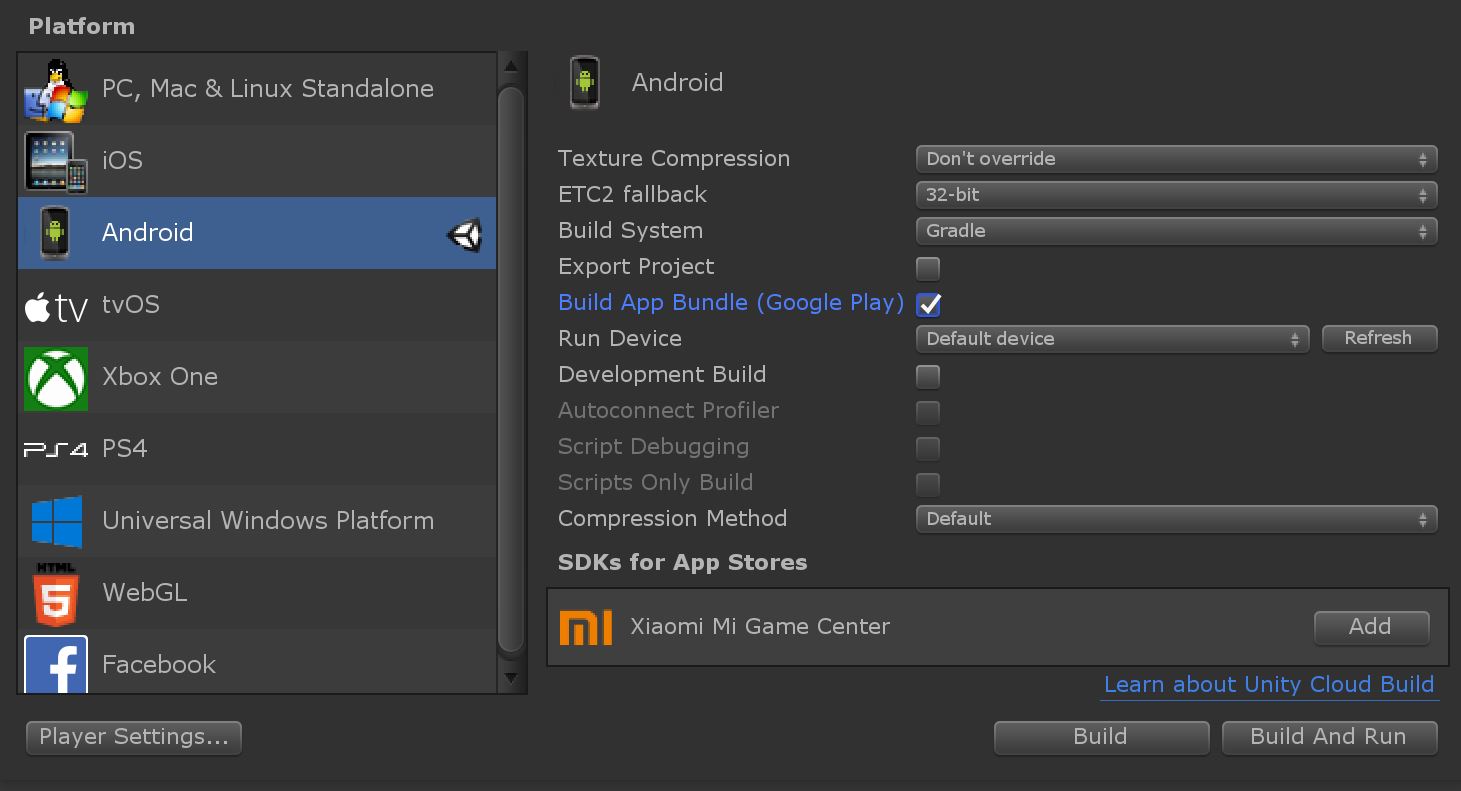
Dynamic Resolution for Mobile (iOS/Android – Vulkan)
Dynamic Resolution for Mobile (iOS/Android – Vulkan)
Added for iOS/tvOS (Metal) and Android (Vulkan) in 2018.3, Dynamic Resolution refers to dynamically scaling some or all of the render targets to reduce workload on the GPU. It can be triggered automatically when performance data indicates that the game is about to drop its frame rate due to being GPU bound. In such a case, gradually scaling down the resolution can help maintain a solid frame rate. It can also be triggered manually if the user is about to experience a particularly GPU-intensive part of gameplay. If scaled gradually, Dynamic Resolution can be virtually unnoticeable.
Added for iOS/tvOS (Metal) and Android (Vulkan) in 2018.3, Dynamic Resolution refers to dynamically scaling some or all of the render targets to reduce workload on the GPU. It can be triggered automatically when performance data indicates that the game is about to drop its frame rate due to being GPU bound. In such a case, gradually scaling down the resolution can help maintain a solid frame rate. It can also be triggered manually if the user is about to experience a particularly GPU-intensive part of gameplay. If scaled gradually, Dynamic Resolution can be virtually unnoticeable.
Android Runtime Permissions
Android Runtime Permissions
On Android 6 (API level 23) and above, the Android.Permission API allows you to request permission to use system features such as the camera, microphone or location when they are needed rather than when the application starts up. You can check if permissions have been granted or not and display a message that explains why you’re asking before the Android system permission dialog appears.
On Android 6 (API level 23) and above, the Android.Permission API allows you to request permission to use system features such as the camera, microphone or location when they are needed rather than when the application starts up. You can check if permissions have been granted or not and display a message that explains why you're asking before the Android system permission dialog appears.
OpenJDK installed with Unity
OpenJDK installed with Unity
By default, Unity now installs a Java Development Kit based on OpenJDK, ensuring you always get the correct JDK version.
By default, Unity now installs a Java Development Kit based on OpenJDK , ensuring you always get the correct JDK version.
游戏机 (Consoles)
DirectX 12 for Xbox One
DirectX 12 for Xbox One
For 2018.3, Unity’s DirectX 12 support is coming to Xbox One.
For 2018.3, Unity's DirectX 12 support is coming to Xbox One.
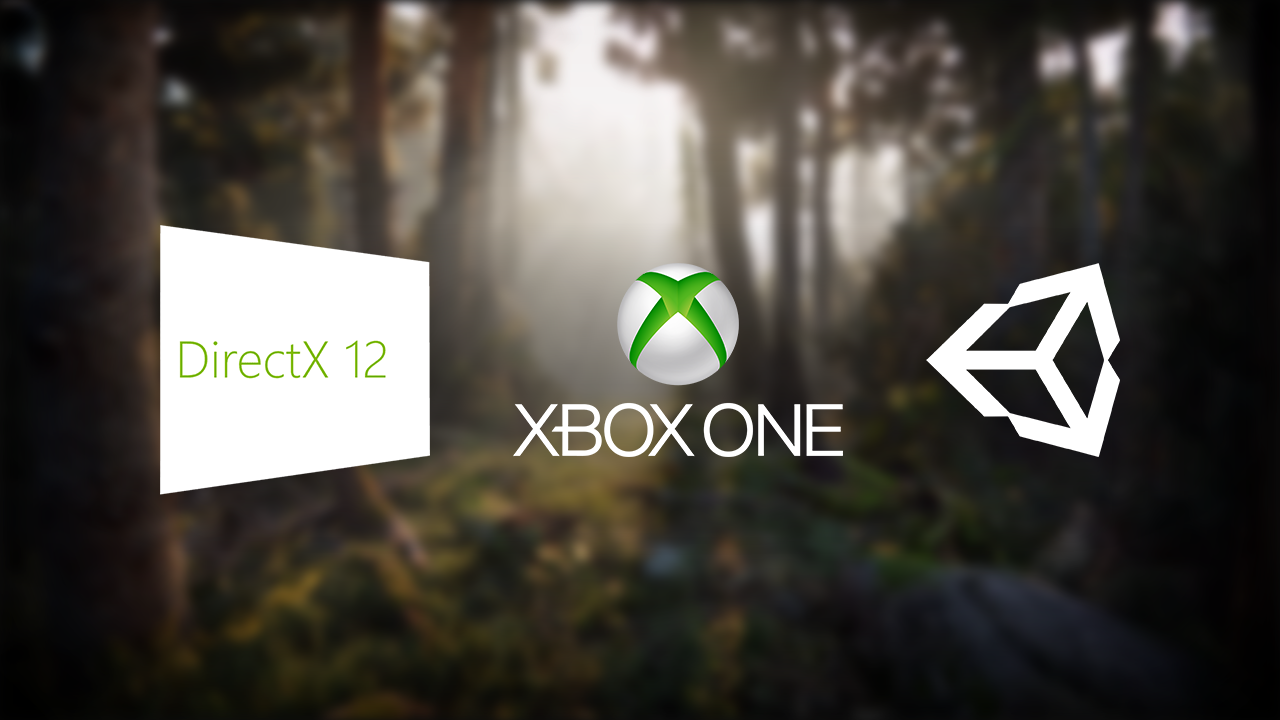
DirectX 12 is a new graphics API that promises to reduce driver overhead and allow better use of multi-core systems. Depending on the game, you could see some impressive performance improvements with DX12. For example, with our Book of the Dead demo we achieved a frame rate increase of 8.72%.
DirectX 12 is a new graphics API that promises to reduce driver overhead and allow better use of multi-core systems. Depending on the game, you could see some impressive performance improvements with DX12. For example, with our Book of the Dead demo we achieved a frame rate increase of 8.72%.
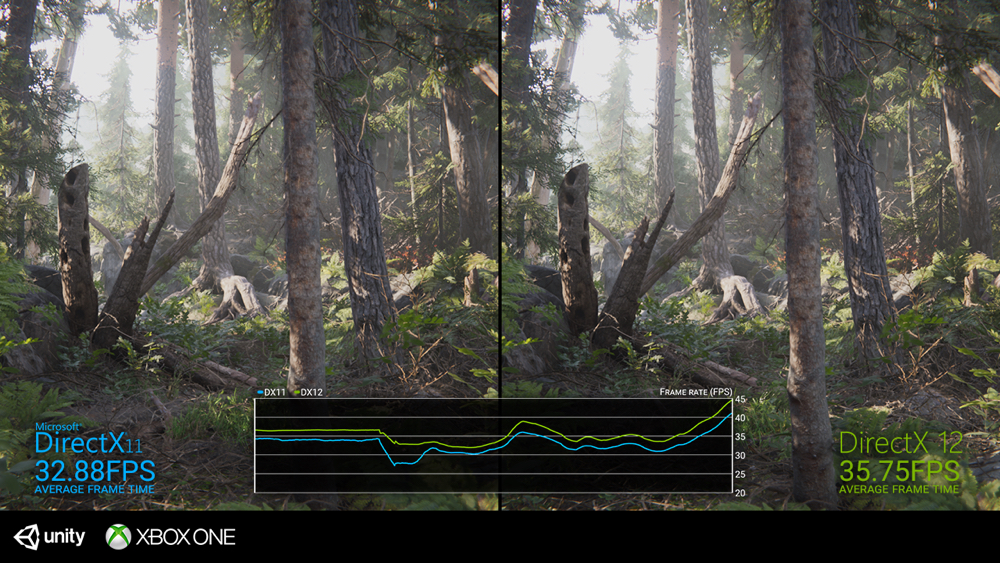
Initially, this will be an experimental feature you can enable. We will release more details in a blog post soon.
Initially, this will be an experimental feature you can enable. We will release more details in a blog post soon.
XR (XR)
Native support for Daydream controllers
Native support for Daydream controllers
This update adds native support for Daydream controller tracking and button input through the Input Manager. See all of the Multi-Platform VR Features in 2018.3 in this blog post.
This update adds native support for Daydream controller tracking and button input through the Input Manager. See all of the Multi-Platform VR Features in 2018.3 in this blog post .
Haptics APIs for VR controllers
Haptics APIs for VR controllers
We now provide APIs for triggering haptics on the Windows Mixed Reality headset controller, Vive controller through OpenVR, and Oculus Touch controllers. We’ll continue expanding platform support and creating more feature abstractions in future releases.
We now provide APIs for triggering haptics on the Windows Mixed Reality headset controller, Vive controller through OpenVR, and Oculus Touch controllers. We'll continue expanding platform support and creating more feature abstractions in future releases.
Updates to AR Foundation
Updates to AR Foundation
We recently made significant updates to AR Foundation and other XR packages. First, you can gain more control of rendering by using the Lightweight Render Pipeline on ARCore and ARKit apps built with AR Foundation. The second new feature is a set of optimized camera image APIs that allow you to efficiently access camera images on the CPU. This is ideal for developers looking to do their own image-processing for things like custom computer-vision algorithms. Finally, we have implemented support for ARKit’s ARWorldMap functionality to share session information.
We recently made significant updates to AR Foundation and other XR packages. First, you can gain more control of rendering by using the Lightweight Render Pipeline on ARCore and ARKit apps built with AR Foundation. The second new feature is a set of optimized camera image APIs that allow you to efficiently access camera images on the CPU. This is ideal for developers looking to do their own image-processing for things like custom computer-vision algorithms. Finally, we have implemented support for ARKit's ARWorldMap functionality to share session information.
XR performance testing We recently added GitHub repositories to help you test your XR projects. The Automated Tests package contains functional, performance, and other types of automated tests for your Unity XR development. You can use the Acceptance Tests project to verify behavior of Unity configurations, compare features between Unity releases, and test for changes in performance.
XR performance testing We recently added GitHub repositories to help you test your XR projects. The Automated Tests package contains functional, performance, and other types of automated tests for your Unity XR development. You can use the Acceptance Tests project to verify behavior of Unity configurations, compare features between Unity releases, and test for changes in performance.
TextMesh Pro (TextMesh Pro)
TextMesh Pro is now a Verified Package in 2018.3. It ships with a new highly optimized Font Generator that enables the generation of glyphs at runtime. Called the Hybrid Dynamic Font System, it allows you to combine both static and dynamic font assets in the same project.
TextMesh Pro is now a Verified Package in 2018.3. It ships with a new highly optimized Font Generator that enables the generation of glyphs at runtime. Called the Hybrid Dynamic Font System, it allows you to combine both static and dynamic font assets in the same project.
DCC (DCC)
FBX Exporter (FBX Exporter)
The FBX Exporter, which was introduced in 2017.2, is now a verified package available in the Unity Package Manager in 2018.3. You can use it to send geometry to any application that supports FBX and back again with minimal effort.
The FBX Exporter, which was introduced in 2017.2, is now a verified package available in the Unity Package Manager in 2018.3. You can use it to send geometry to any application that supports FBX and back again with minimal effort.
Physical cameras (Physical cameras)
Building on the existing Unity camera system, a second real-world camera mode is now available. The new mode is based on the focal length and sensor size rather than vertical field of view controls, which makes it more natural for cinematographers and artists used to physical cameras. It also supports more natural lens effects like vignetting, chromatic aberration and flares.
Building on the existing Unity camera system, a second real-world camera mode is now available. The new mode is based on the focal length and sensor size rather than vertical field of view controls, which makes it more natural for cinematographers and artists used to physical cameras. It also supports more natural lens effects like vignetting, chromatic aberration and flares.
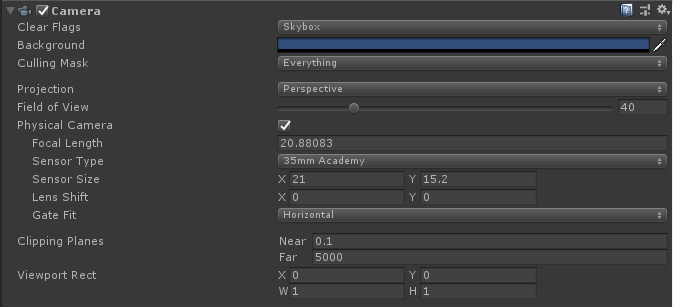
Autodesk Interactive Shader support in SRP (Autodesk Interactive Shader support in SRP)
We used Shader Graph to create an “Autodesk Interactive” shader asset to support the previous roughness setup (note that the Autodesk Interactive Shader was previously called the Stingray PBS shader in Autodesk Maya and Autodesk 3ds Max).
We used Shader Graph to create an “Autodesk Interactive” shader asset to support the previous roughness setup (note that the Autodesk Interactive Shader was previously called the Stingray PBS shader in Autodesk Maya and Autodesk 3ds Max).
图形 (Graphics)
Visual Effect Graph (Preview) (Visual Effect Graph (Preview))
Our new Visual Effect Graph is available in Preview in 2018.3 with HDRP. Use it to author configurable, reusable next-generation effects, ranging from simple to complex, and handle millions of particles on GPU. This easy-to-use, flexible node-based system, which is inspired by the leading tools for VFX in film, lets you create stunning effects for games and other creative content quickly.
Our new Visual Effect Graph is available in Preview in 2018.3 with HDRP. Use it to author configurable, reusable next-generation effects, ranging from simple to complex, and handle millions of particles on GPU. This easy-to-use, flexible node-based system, which is inspired by the leading tools for VFX in film, lets you create stunning effects for games and other creative content quickly.
You can drag-and-drop ready-made nodes for simple effects or you can use it to create more advanced effects. It’s also designed to be responsive, allowing you to see all your changes in real-time as you work.
You can drag-and-drop ready-made nodes for simple effects or you can use it to create more advanced effects. It's also designed to be responsive, allowing you to see all your changes in real-time as you work.
The Visual Effect Graph architecture enables you to generate millions of particles on the GPU without compromising on performance.
The Visual Effect Graph architecture enables you to generate millions of particles on the GPU without compromising on performance.
Spaceship VFX graph demo showcased at Unite LA 2018
Spaceship VFX graph demo showcased at Unite LA 2018
Every asset contains a graph with all the behavior for a standalone effect. An effect can comprise of any combination of meshes, particles and other simulation containers, all handled by Visual Effect Graph, which is also integrated with other tools like Timeline.
Every asset contains a graph with all the behavior for a standalone effect. An effect can comprise of any combination of meshes, particles and other simulation containers, all handled by Visual Effect Graph, which is also integrated with other tools like Timeline .
The Visual Effect Graph currently supports the HDRP, and LWRP support is coming later next year. We would love to hear what you think and get your feedback while we’re working on improving it. To get started visit, visit our resource page.
The Visual Effect Graph currently supports the HDRP, and LWRP support is coming later next year. We would love to hear what you think and get your feedback while we're working on improving it. To get started visit, visit our resource page .
Lighting improvements (Lighting improvements)
2018.3 introduces Configurable Falloff for punctual lights. This change to both CPU and GPU Progressive lightmappers means that even when you’re not using a Scriptable Render Pipeline, baked lights can be configured via script to use physically correct “inverse square falloff.” The result is that baked lighting will more closely resemble real-world lighting, with bright hotspots and long, slowly attenuating falloff. This means more realistic lighting and improves the overall believability of your lightmapped scenes.
2018.3 introduces Configurable Falloff for punctual lights. This change to both CPU and GPU Progressive lightmappers means that even when you're not using a Scriptable Render Pipeline, baked lights can be configured via script to use physically correct “inverse square falloff.” The result is that baked lighting will more closely resemble real-world lighting, with bright hotspots and long, slowly attenuating falloff. This means more realistic lighting and improves the overall believability of your lightmapped scenes.
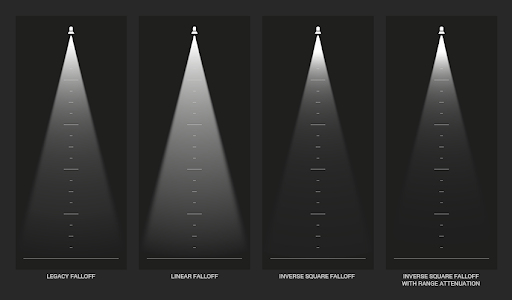
We have also implemented Light Probe Deringing. You can toggle on the Light Probe Group to implement windowing on probes. Windowing can alleviate negative values and banding (common sampling issues associated with the spherical harmonic functions used by Light Probes).
We have also implemented Light Probe Deringing. You can toggle on the Light Probe Group to implement windowing on probes. Windowing can alleviate negative values and banding (common sampling issues associated with the spherical harmonic functions used by Light Probes).
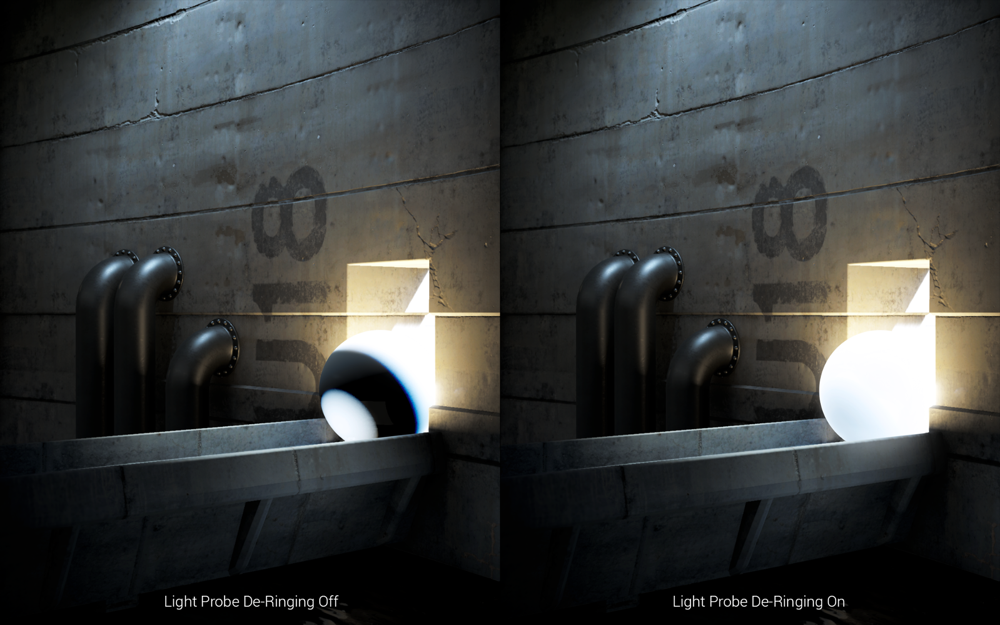
Disc area lights have been introduced as a feature specific to the CPU and GPU Progressive lightmappers in 2018.3. This area light shape is useful in architectural visualizations and other applications where you might need to add round light apertures. For these cases, a rectangular light shape would not be a suitable fit. Disc lights offer other interesting characteristics such as a smaller hotspot and softer penumbra towards the edges of the light, which is another useful addition to the lighting artist’s tool bag.
Disc area lights have been introduced as a feature specific to the CPU and GPU Progressive lightmappers in 2018.3. This area light shape is useful in architectural visualizations and other applications where you might need to add round light apertures. For these cases, a rectangular light shape would not be a suitable fit. Disc lights offer other interesting characteristics such as a smaller hotspot and softer penumbra towards the edges of the light, which is another useful addition to the lighting artist's tool bag.
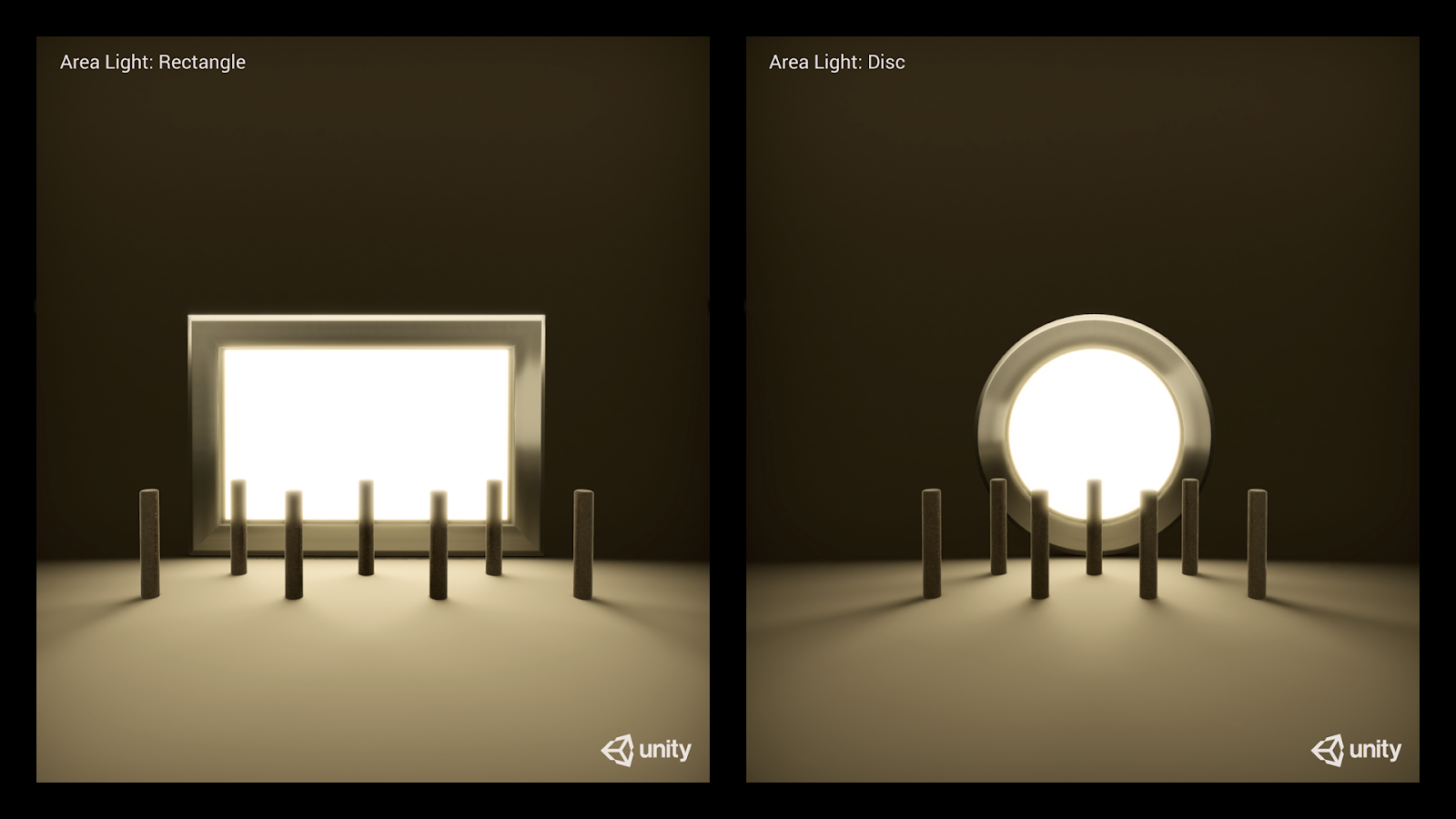
GPU Progressive Lightmapper (Windows Preview) (GPU Progressive Lightmapper (Windows Preview))
In 2018.3, we are introducing the GPU Progressive Lightmapper in Preview for Windows. On machines with powerful GPUs, lightmap baking with the GPU Progressive Lightmapper will be significantly faster. We built a pure path-tracing-based algorithm on top of Radeon Rays and OpenCL for baking lightmaps in Unity, bringing performance improvements that are over 10x the CPU version. Since it’s a Preview, it has a limited feature set and will eventually support all of the lighting features in Unity.
In 2018.3, we are introducing the GPU Progressive Lightmapper in Preview for Windows. On machines with powerful GPUs, lightmap baking with the GPU Progressive Lightmapper will be significantly faster. We built a pure path-tracing-based algorithm on top of Radeon Rays and OpenCL for baking lightmaps in Unity, bringing performance improvements that are over 10x the CPU version. Since it's a Preview, it has a limited feature set and will eventually support all of the lighting features in Unity.
You can try out the GPU Lightmapper from the Lighting window. It works on all modern GPUs with more than 2GB of dedicated memory, but more memory is recommended for larger lightmaps. Let us know what you think in the forum.
You can try out the GPU Lightmapper from the Lighting window. It works on all modern GPUs with more than 2GB of dedicated memory, but more memory is recommended for larger lightmaps. 让我们知道您在 论坛中的 想法 。
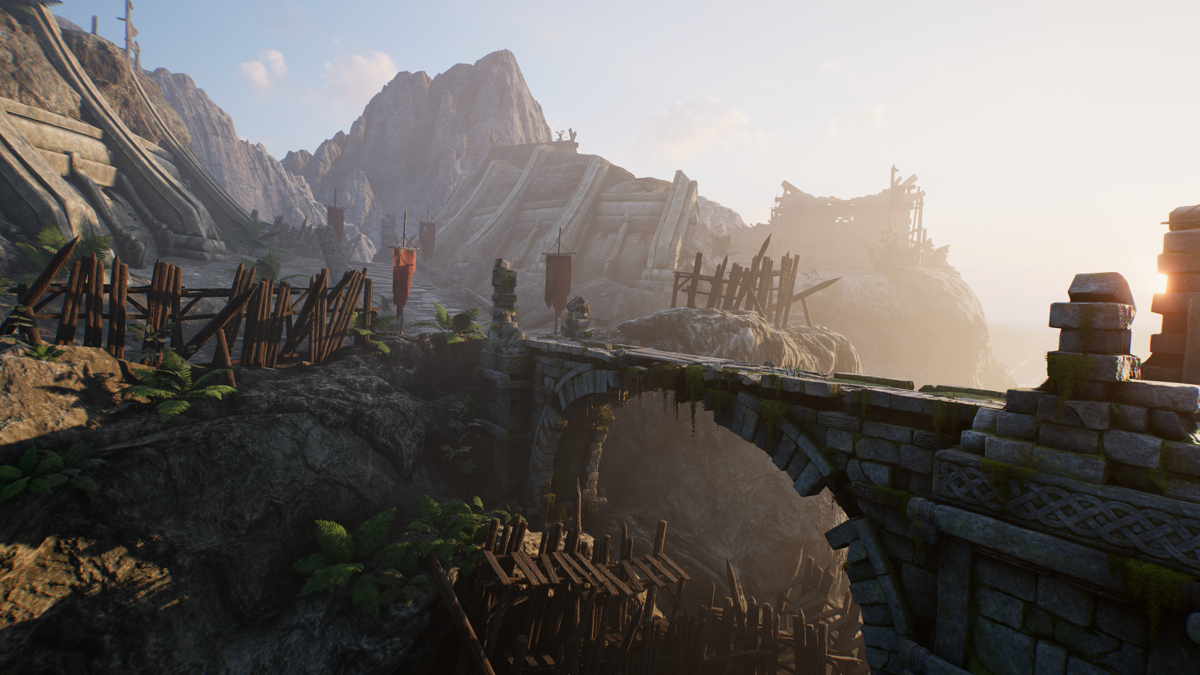
The 2018.3 release includes support for progressive updates, multiple lightmaps, direct lighting, indirect lighting, AO, all light types, environment lighting, emission, multiple bounces, and finally GPU compositing, culling and convergence testing.
The 2018.3 release includes support for progressive updates, multiple lightmaps, direct lighting, indirect lighting, AO, all light types, environment lighting, emission, multiple bounces, and finally GPU compositing, culling and convergence testing.
We’re working on adding Linux and macOS support for 2019.1.
We're working on adding Linux and macOS support for 2019.1.
Lightweight Render Pipeline (Preview) (Lightweight Render Pipeline (Preview))
We have added several improvements to the Lightweight Render Pipeline (LWRP) and are expecting it to leave Preview status and be ready for production in 2019.1. In 2018.3, we’ve added Physically Based Light Attenuation, Custom Renderer, and Custom Render Pass Injection.
We have added several improvements to the Lightweight Render Pipeline (LWRP) and are expecting it to leave Preview status and be ready for production in 2019.1. In 2018.3, we've added Physically Based Light Attenuation, Custom Renderer, and Custom Render Pass Injection.
Physically Based Light Attenuation
Physically Based Light Attenuation
LWRP now uses Inverse Squared Falloff (with range attenuation) for both real-time and baked lights. This provides more accurate results in different light conditions and allows for lights with smaller ranges, which in turn improves the performance of per-object light culling. When you upgrade from previous versions to 4.1.0-preview, you will have to upgrade some light settings in your scene.
LWRP now uses Inverse Squared Falloff (with range attenuation) for both real-time and baked lights. This provides more accurate results in different light conditions and allows for lights with smaller ranges, which in turn improves the performance of per-object light culling. When you upgrade from previous versions to 4.1.0-preview, you will have to upgrade some light settings in your scene.
Improved shadow quality
Improved shadow quality
Depth and Normal shadow bias offsets are now scaled by shadowmap texel size. This gives you finer control when tweaking shadow acne. The settings work regardless of the amount of shadow cascades and shadow resolution.
Depth and Normal shadow bias offsets are now scaled by shadowmap texel size. This gives you finer control when tweaking shadow acne. The settings work regardless of the amount of shadow cascades and shadow resolution.
Custom render passes
Custom render passes
LWRP now provides an easy workflow to extend its renderer. You can create a custom render passes with ScriptableRenderPass class and schedule them in the renderer. There are two ways of injecting custom render passes in LWRP.
LWRP now provides an easy workflow to extend its renderer. You can create a custom render passes with ScriptableRenderPass class and schedule them in the renderer. There are two ways of injecting custom render passes in LWRP.
You can also completely override the LWRP renderer by implementing an IRendererSetup. A renderer setup is a script that can be attached to a camera, which executes all ScriptableRenderPasses registered in it. You can use this to implement different rendering strategies such as Forward+ or Deferred Rendering.
You can also completely override the LWRP renderer by implementing an IRendererSetup . A renderer setup is a script that can be attached to a camera, which executes all ScriptableRenderPasses registered in it. You can use this to implement different rendering strategies such as Forward+ or Deferred Rendering.
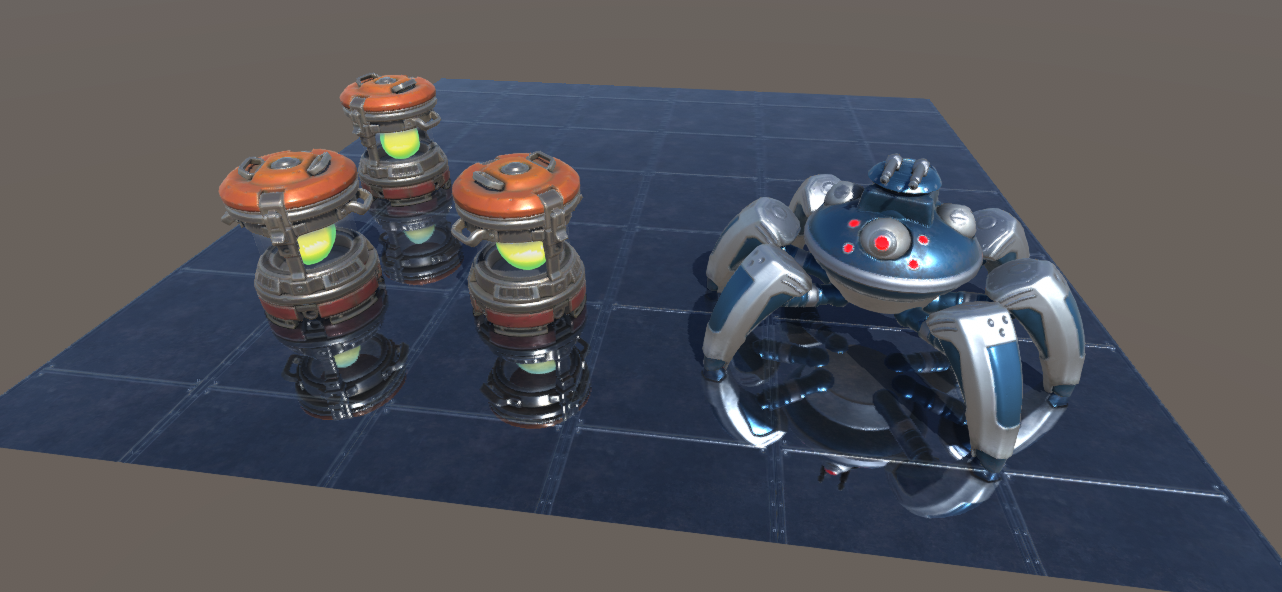
Here, we used a ScriptableRenderPass to create a planar reflection texture. We then used that texture in Shader Graph, where we applied it to the metallic floor.
Here, we used a ScriptableRenderPass to create a planar reflection texture. We then used that texture in Shader Graph, where we applied it to the metallic floor.

In this example, we converted the command buffer example for the Built-in render pipeline to blur refractions via a ScriptableRenderPass.
In this example, we converted the command buffer example for the Built-in render pipeline to blur refractions via a ScriptableRenderPass.
Documentation updates
Documentation updates
You can find documentation for LWRP by clicking View Documentation in the Package Manager window. This takes you to the LWRP-specific documentation site. We’ve added documentation for some shaders (Lit and Simple Lit), and we’re planning to document all of LWRP for 2019.1.
You can find documentation for LWRP by clicking View Documentation in the Package Manager window. This takes you to the LWRP-specific documentation site. We've added documentation for some shaders (Lit and Simple Lit), and we're planning to document all of LWRP for 2019.1.
Performance improvements
Performance improvements
We added improvements when shading point and spot lights in GLES2, and improvements for GPUs that support HSR.
We added improvements when shading point and spot lights in GLES2, and improvements for GPUs that support HSR.
For more information, please check the LWRP changelog available in the PackageManager UI. You can also get our Boat Attack demo, which was created to aid the testing and development of LWRP.
For more information, please check the LWRP changelog available in the PackageManager UI. You can also get our Boat Attack demo, which was created to aid the testing and development of LWRP.
Comparing Built-in render pipeline to LWRP
Comparing Built-in render pipeline to LWRP
The Built-in render pipeline culls the lights at a per-object level. It shades each light in a separate render pass. LWRP also culls lights per object. However, it shades all lights in a single pass, which results in fewer batches.
The Built-in render pipeline culls the lights at a per-object level. It shades each light in a separate render pass. LWRP also culls lights per object. However, it shades all lights in a single pass, which results in fewer batches.
The screenshot below shows a scene from our Angry Bots 2 demo. Here, we’re comparing real-time lighting and shadows in the Unity built-in render pipeline (left) and LWRP (right). We’re using the forward rendering path in the Built-in render pipeline (LWRP only supports forward rendering).
The screenshot below shows a scene from our Angry Bots 2 demo. Here, we're comparing real-time lighting and shadows in the Unity built-in render pipeline (left) and LWRP (right). We're using the forward rendering path in the Built-in render pipeline (LWRP only supports forward rendering).
Both scenes use the same light setup:
Both scenes use the same light setup:
1 Directional light (soft shadows)
1 Directional light (soft shadows)
2 Point lights (no shadows)
2 Point lights (no shadows)
2 Spot lights (soft shadows)
2 Spot lights (soft shadows)
To match the lighting in the Built-in render pipeline, we increased the Point and Spot light intensity in the LWRP scene. This didn’t cause any extra performance cost.
To match the lighting in the Built-in render pipeline, we increased the Point and Spot light intensity in the LWRP scene. This didn't cause any extra performance cost.


Realtime lighting and shadows in LWRP (right) can visually match those in the Built-in render pipeline (left), but with fewer batches and draw calls.
Realtime lighting and shadows in LWRP (right) can visually match those in the Built-in render pipeline (left), but with fewer batches and draw calls.
High Definition Render Pipeline (Preview) (High Definition Render Pipeline (Preview))
High-Definition Render Pipeline (HDRP) is dedicated to high-end visuals and games. In the 2018.3 release, we have added and improved several features to achieve better visual quality and an improved workflow for artists. This version is also more stable and includes better support for Metal for Mac, Vulkan for PC, Xbox One and PS4.
High-Definition Render Pipeline (HDRP) is dedicated to high-end visuals and games. In the 2018.3 release, we have added and improved several features to achieve better visual quality and an improved workflow for artists. This version is also more stable and includes better support for Metal for Mac, Vulkan for PC, Xbox One and PS4.
As well, we have added preliminary support for VR and MSAA. The UI has been updated for the various inspectors of HDRP elements: Camera, Lights, Reflections Probe, and Material. There’s also a new lighting model, so you can author more complex materials.
As well, we have added preliminary support for VR and MSAA. The UI has been updated for the various inspectors of HDRP elements: Camera, Lights, Reflections Probe, and Material. There's also a new lighting model, so you can author more complex materials.
Note: This release comes with package 4.1.0 of HDRP in the HDRP template. To take advantage of the features listed here, we recommend that you upgrade to package 4.6.0 after installing the template.
Note: This release comes with package 4.1.0 of HDRP in the HDRP template. To take advantage of the features listed here, we recommend that you upgrade to package 4.6.0 after installing the template.
Platform support, performance, and stability
Platform support, performance, and stability
2018.3 adds better support for Metal and Vulkan APIs, including fewer artifacts and better performance. Artifacts still remain in fog and decals on transparent objects, but the overall experience has been greatly improved compared to previous versions.
2018.3 adds better support for Metal and Vulkan APIs, including fewer artifacts and better performance. Artifacts still remain in fog and decals on transparent objects, but the overall experience has been greatly improved compared to previous versions.
Preliminary support for VR is now available. Please read this article for details on how to set up your project. VR requires forward-rendering mode. Camera-relative rendering is still not supported, and there are currently some issues with lighting and volumetrics.
Preliminary support for VR is now available. Please read this article for details on how to set up your project. VR requires forward-rendering mode. Camera-relative rendering is still not supported, and there are currently some issues with lighting and volumetrics.
Coupled with VR and forward rendering, this version adds preliminary support of MSAA. All effects are currently handled with MSAA (for example, SSAO, Contact shadow), except Screen Space Reflection. Note that MSAA adds extra cost to the rendering, so it should be used with care.
Coupled with VR and forward rendering, this version adds preliminary support of MSAA. All effects are currently handled with MSAA (for example, SSAO, Contact shadow), except Screen Space Reflection. Note that MSAA adds extra cost to the rendering, so it should be used with care.
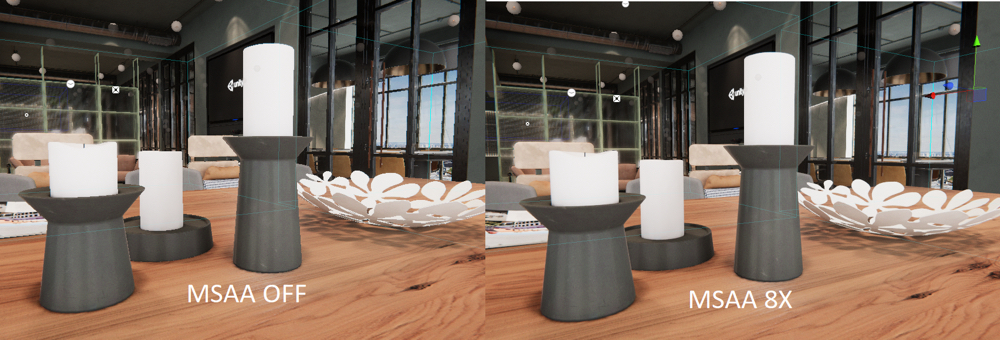

Unity 2018.3 provides better HDRP performance for PS4 and XBox One. It is now possible to execute several effects with async compute pipeline: Screen Space Ambient Occlusion, Screen Space Reflection, Voxelization of Density volume, Light culling, and Material classification. All these effects can be executed with parallel of the shadow-rendering pass.
Unity 2018.3 provides better HDRP performance for PS4 and XBox One. It is now possible to execute several effects with async compute pipeline: Screen Space Ambient Occlusion, Screen Space Reflection, Voxelization of Density volume, Light culling, and Material classification. All these effects can be executed with parallel of the shadow-rendering pass.
The forward-rendering path has been improved by performing a technique called “scalarization.” This technique is specific to AMD GCN architecture used on consoles. To read more about it, see this blog post by one of the members of the HDRP team.
The forward-rendering path has been improved by performing a technique called “scalarization.” This technique is specific to AMD GCN architecture used on consoles. To read more about it, see this blog post by one of the members of the HDRP team.
Lastly, you can now have more fine-grained control of which shader variants are included in your build, via the Render Pipeline Settings. If you exclude variants you know that you won’t use, you can drastically reduce the build time. As well, more shader variants are rejected.
Lastly, you can now have more fine-grained control of which shader variants are included in your build, via the Render Pipeline Settings. If you exclude variants you know that you won't use, you can drastically reduce the build time. As well, more shader variants are rejected.
Improved UI and Camera control
Improved UI and Camera control
The HDRP UX has been simplified. In addition, you now have more control through FrameSettings. Since FrameSettings now supports the same override system as post-processing, it can inherit values from RenderPipelineSettings and override them. The camera now supports the Physical camera parametrization of Unity’s built-in render pipeline.
The HDRP UX has been simplified. In addition, you now have more control through FrameSettings. Since FrameSettings now supports the same override system as post-processing, it can inherit values from RenderPipelineSettings and override them. The camera now supports the Physical camera parametrization of Unity's built-in render pipeline.
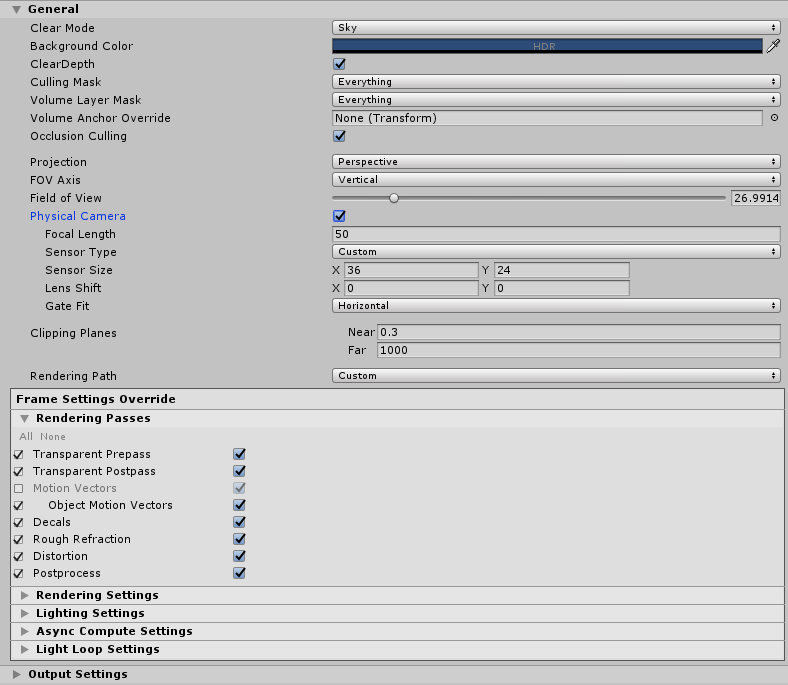
In the Light and Reflection probe Inspectors, there is now a toggle for advanced settings, so the UI is not cluttered with a lot of default parameters.
In the Light and Reflection probe Inspectors, there is now a toggle for advanced settings, so the UI is not cluttered with a lot of default parameters.
Improved quality and control of current features
Improved quality and control of current features
Volumetric fog rendering has been improved with a technique called “deep compositing.” To read more it, see this blog post by one of the members of the HDRP team. This technique enables you to better compose density volumes that overlap each other with the global fog. In addition, volumetric fog can now fall back with an exponential fog at far distances and support activation of Height Fog. Parametrization and control of volumetric and density volume have become more artist-friendly. Lastly, lighting of the volumetric voxels performance has been improved.
Volumetric fog rendering has been improved with a technique called “deep compositing.” To read more it, see this blog post by one of the members of the HDRP team. This technique enables you to better compose density volumes that overlap each other with the global fog. In addition, volumetric fog can now fall back with an exponential fog at far distances and support activation of Height Fog. Parametrization and control of volumetric and density volume have become more artist-friendly. Lastly, lighting of the volumetric voxels performance has been improved.
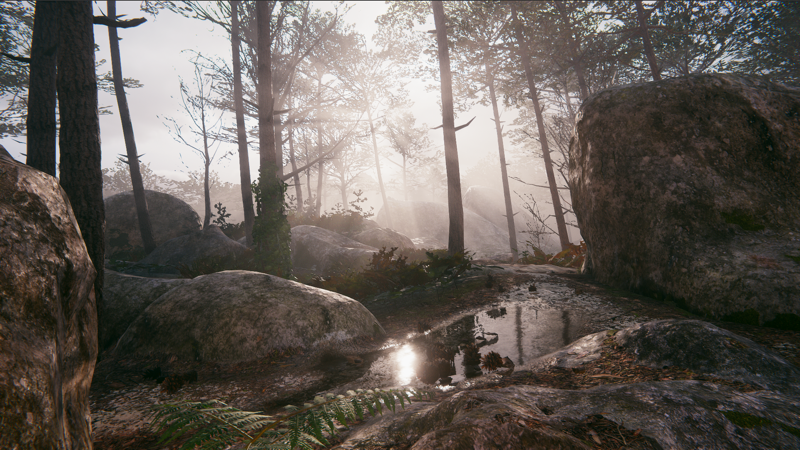
Volumetric effect from a directional light with shadow allowing you to see light shafts through the tree.
Volumetric effect from a directional light with shadow allowing you to see light shafts through the tree.
The Shadow system is now more stable and offers more control. There are three levels of quality for shadows: Low, Medium and High. These map to different filtering algorithms (PCF and PCSS in this version).
The Shadow system is now more stable and offers more control. There are three levels of quality for shadows: Low, Medium and High. These map to different filtering algorithms (PCF and PCSS in this version).
Note: You can only switch between the different quality modes when you use the forward-rendering path. The deferred path defaults to Low quality. Low quality is the default mode for consoles for now.
Note: You can only switch between the different quality modes when you use the forward-rendering path. The deferred path defaults to Low quality. Low quality is the default mode for consoles for now.
The memory management of shadow map with a shadow atlas has been improved. There is now a budget for a number of visible shadows on screen. In addition, the shadow framework now scales the shadow map resolution according to the distance, and it automatically resizes shadows to fit in the atlas if there is no room. This means that shadows will always be displayed – but they will have lower quality when they don’t fit in the shadow atlas.
The memory management of shadow map with a shadow atlas has been improved. There is now a budget for a number of visible shadows on screen. In addition, the shadow framework now scales the shadow map resolution according to the distance, and it automatically resizes shadows to fit in the atlas if there is no room. This means that shadows will always be displayed – but they will have lower quality when they don't fit in the shadow atlas.
Contact shadows can now be enabled independently of the shadow map. Contact shadows are supported for directional, point or spot light, but you can currently only use one at a time. We have also improved quality and performance.
Contact shadows can now be enabled independently of the shadow map. Contact shadows are supported for directional, point or spot light, but you can currently only use one at a time. We have also improved quality and performance.
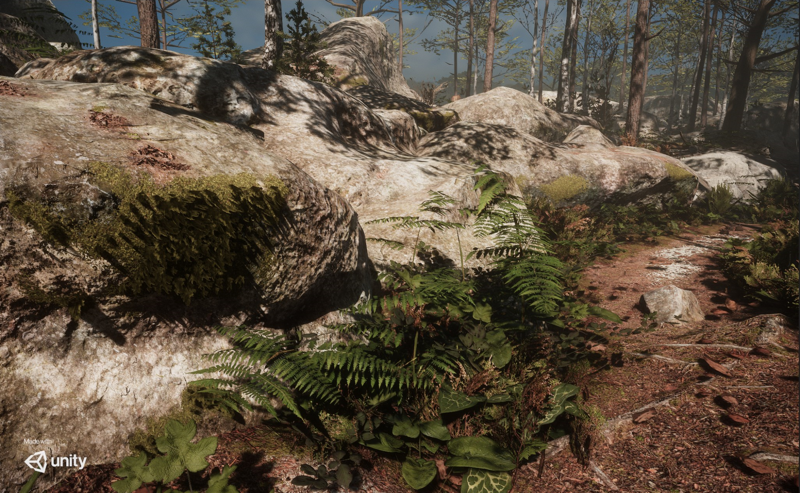
Off Scene without contact shadow enabled on the directional light.
Off Scene without contact shadow enabled on the directional light.
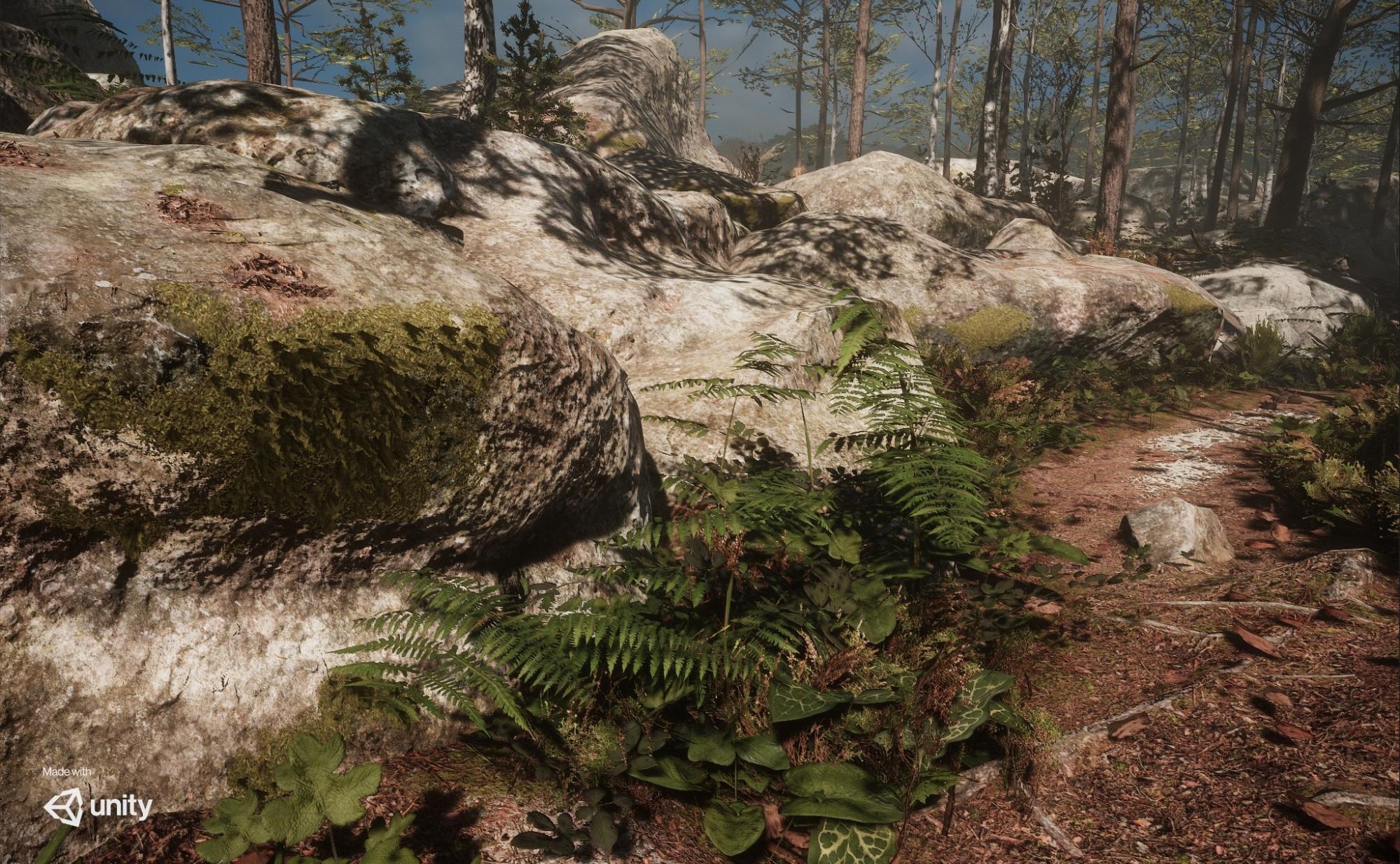
On scene with contact shadow enabled on the directional light.
On scene with contact shadow enabled on the directional light.
To help you debug shadows, we’ve added a new set of tools to the Render Pipeline Debug windows. You can now display shadows for each individual light, the shadow atlas, the scaling factor of each shadow map, as well as shadow masks.
To help you debug shadows, we've added a new set of tools to the Render Pipeline Debug windows. You can now display shadows for each individual light, the shadow atlas, the scaling factor of each shadow map, as well as shadow masks.
Decals have been enhanced with a per-channel selection mask. With this, you can create decals that affect only a subset of material properties. For example, you can make a decal that only modifies the normal property of a material, the metallic surface, or the smoothness. There are now two modes:
Decals have been enhanced with a per-channel selection mask. With this, you can create decals that affect only a subset of material properties. For example, you can make a decal that only modifies the normal property of a material, the metallic surface, or the smoothness. There are now two modes:
BaseColor, Normal, and Smoothness
BaseColor, Normal, and Smoothness
BaseColor, Normal, Smoothness, Metal and AO (more expensive)
BaseColor, Normal, Smoothness, Metal and AO (more expensive)
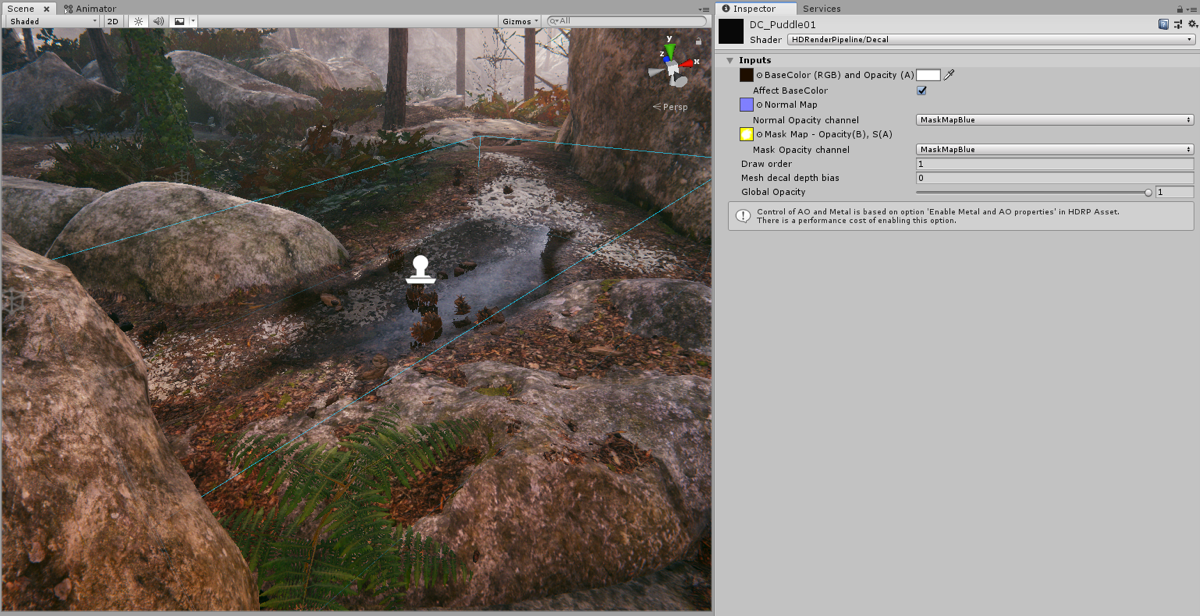
We’ve also improved Decal gizmos: You can now control depth bias and draw order.
We've also improved Decal gizmos: You can now control depth bias and draw order.
With the forward-rendering path, Decal now correctly affects the normal buffer, which allows it to correctly affect Screen Space Reflection.
With the forward-rendering path, Decal now correctly affects the normal buffer, which allows it to correctly affect Screen Space Reflection.
We have added additional controls to Lights. For example, they now support the physical units EV100 and Lux At a distance, in addition to Candela and Lumens. The HDRI sky can use Lux values. For directional lights, you can now control the shape of the highlight to better mimic the sun disc. Point and Spot lights have a softer attenuation. Light explorer now supports every light type in HDRP.
We have added additional controls to Lights. For example, they now support the physical units EV100 and Lux At a distance, in addition to Candela and Lumens. The HDRI sky can use Lux values. For directional lights, you can now control the shape of the highlight to better mimic the sun disc. Point and Spot lights have a softer attenuation. Light explorer now supports every light type in HDRP.
Improvements to the reflection system
Improvements to the reflection system
2018.3 also brings Screen Space Reflections (SSR). With this, you can enable reflection on every smooth surface. Rough surfaces fall back to regular Reflection Probe / Planar Reflection. You can tag Materials to not receive SSR.
2018.3 also brings Screen Space Reflections (SSR). With this, you can enable reflection on every smooth surface. Rough surfaces fall back to regular Reflection Probe / Planar Reflection. You can tag Materials to not receive SSR.
Note: This effect is currently expensive when using a large resolution.
Note: This effect is currently expensive when using a large resolution.

On the left, a scene without planar reflection; on the right, a scene with planar reflection. Note the reflection of the sky on the floor.
On the left, a scene without planar reflection; on the right, a scene with planar reflection. Note the reflection of the sky on the floor.
This version also introduces Planar Reflection, which you can use to get high-quality reflections on planar surfaces. The planar probe component behaves exactly as the reflection probe component, except it is rendered in real-time. They have the same set of controls as Reflection Probes.
This version also introduces Planar Reflection, which you can use to get high-quality reflections on planar surfaces. The planar probe component behaves exactly as the reflection probe component, except it is rendered in real-time. They have the same set of controls as Reflection Probes.
Reflection control: The Reflection Probe and Planar Reflection UI has been updated to provide a better workflow for artists. You can now control the FrameSettings for the rendering of the real-time reflection.
Reflection control: The Reflection Probe and Planar Reflection UI has been updated to provide a better workflow for artists. You can now control the FrameSettings for the rendering of the real-time reflection.
Better feature parity with Built-In render pipeline
Better feature parity with Built-In render pipeline
With Light layering, you can tag lights and objects, so only objects with the same tags receive lighting from a specific light. It is also available in the built-in render pipeline. In HDRP, the lighting architecture is different, which has required a revamp of this feature. In this version, we introduce light layers that work with Punctual lights, Area lights, Reflection Probes and Planar reflection. This first version supports up to 31 lights. Currently, shadows are not handled correctly.
With Light layering, you can tag lights and objects, so only objects with the same tags receive lighting from a specific light. It is also available in the built-in render pipeline. In HDRP, the lighting architecture is different, which has required a revamp of this feature. In this version, we introduce light layers that work with Punctual lights, Area lights, Reflection Probes and Planar reflection. This first version supports up to 31 lights. Currently, shadows are not handled correctly.
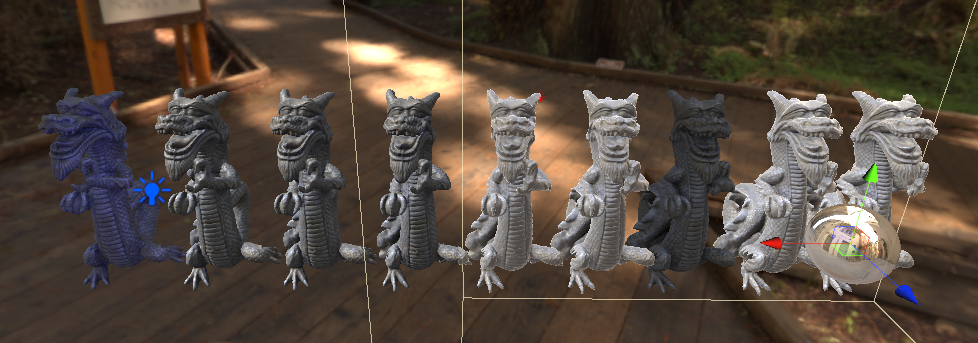
These dragons have different light-layer tags. There is a point light on the right and a Reflection Probe on the left. The far-left dragon is blue as it is the only one affected by the blue light, due to matching tags. The dark-grey dragon (third from the right) is not affected by the local Reflection Probe as it doesn’t match its tag.
These dragons have different light-layer tags. There is a point light on the right and a Reflection Probe on the left. The far-left dragon is blue as it is the only one affected by the blue light, due to matching tags. The dark-grey dragon (third from the right) is not affected by the local Reflection Probe as it doesn't match its tag.
Terrain is a feature of the Built-in render pipeline that was not compatible with HDRP. This version introduces the Terrain Lit shader, which enables compatibility with the Built-in Terrain system. It supports up to eight layers in a single draw call. The Terrain Lit shader uses the same lighting model as the Lit shader, but only offers a restricted set of options that are available in the LayeredLit shader. Note: There is currently no tessellation or displacement supported in Terrain Lit shader.
Terrain is a feature of the Built-in render pipeline that was not compatible with HDRP. This version introduces the Terrain Lit shader, which enables compatibility with the Built-in Terrain system. It supports up to eight layers in a single draw call. The Terrain Lit shader uses the same lighting model as the Lit shader, but only offers a restricted set of options that are available in the LayeredLit shader. Note: There is currently no tessellation or displacement supported in Terrain Lit shader.
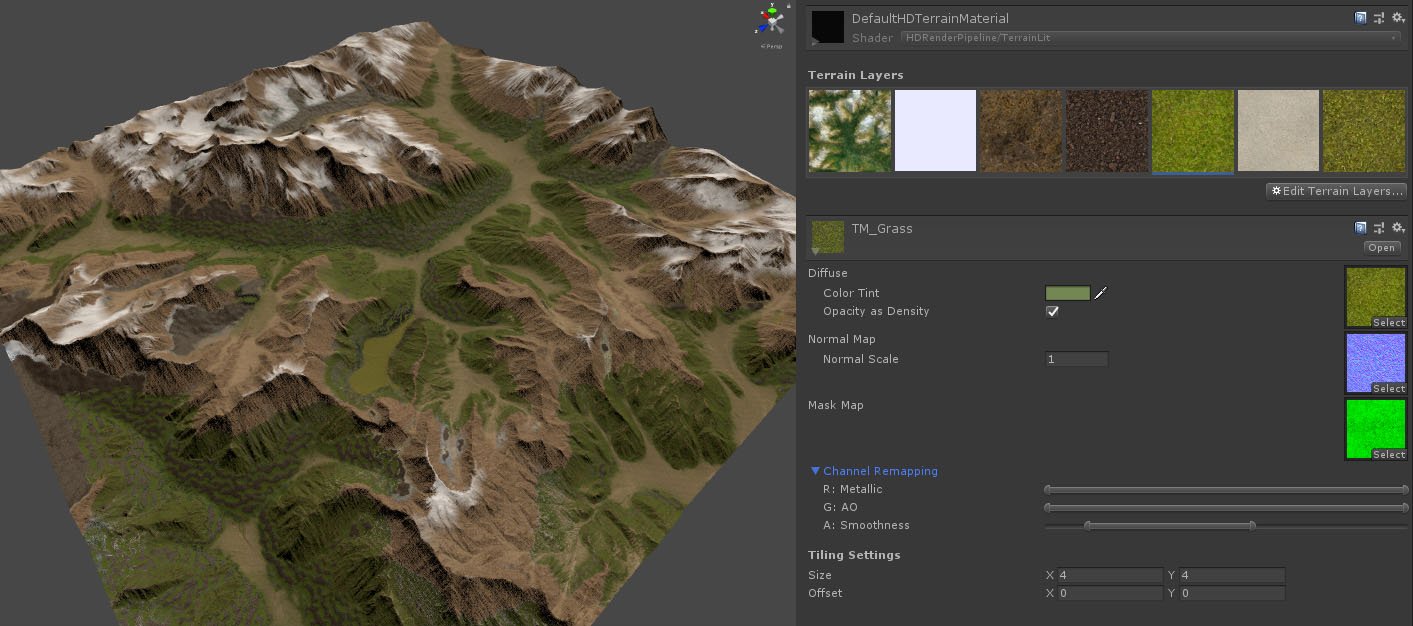
Example of Terrain Lit material.
Example of Terrain Lit material.
Rendering particles in the built-in render pipeline is supported via the Particle System. In HDRP, only unlit Particle System shaders are supported. To use lit particles and have effects author on GPU, this version supports the new Visual Effect Graph, which can use the Lit shader as well as a simplified version called “Simple Lit.” This simpler shader gives better performance for drawing large amounts of lit particles.
Rendering particles in the built-in render pipeline is supported via the Particle System. In HDRP, only unlit Particle System shaders are supported. To use lit particles and have effects author on GPU, this version supports the new Visual Effect Graph, which can use the Lit shader as well as a simplified version called “Simple Lit.” This simpler shader gives better performance for drawing large amounts of lit particles.

Right, the nodal graph used to author an effect in Visual Effect Graph. Left, the resulting effect created with millions of particles and running fully on GPU.
Right, the nodal graph used to author an effect in Visual Effect Graph. Left, the resulting effect created with millions of particles and running fully on GPU.
More debugging tools
More debugging tools
Debug tools are always important because they enable you to track issues and keep monitoring performance. In this version, we have added several new debug modifications to the Render Pipeline debug windows:
Debug tools are always important because they enable you to track issues and keep monitoring performance. In this version, we have added several new debug modifications to the Render Pipeline debug windows:
Display of individual shadow/Shadow Atlas/Shadow scaling factor
Display of individual shadow/Shadow Atlas/Shadow scaling factor
Override of emissive color
Override of emissive color
Screen-Space Reflection debug mode
Screen-Space Reflection debug mode
Luminance meter mode
Luminance meter mode
Ability to disable Light by type
Ability to disable Light by type
Freeze camera culling, so you can check what objects have been culled through the camera frustum
Freeze camera culling, so you can check what objects have been culled through the camera frustum
Display light volumes
Display light volumes
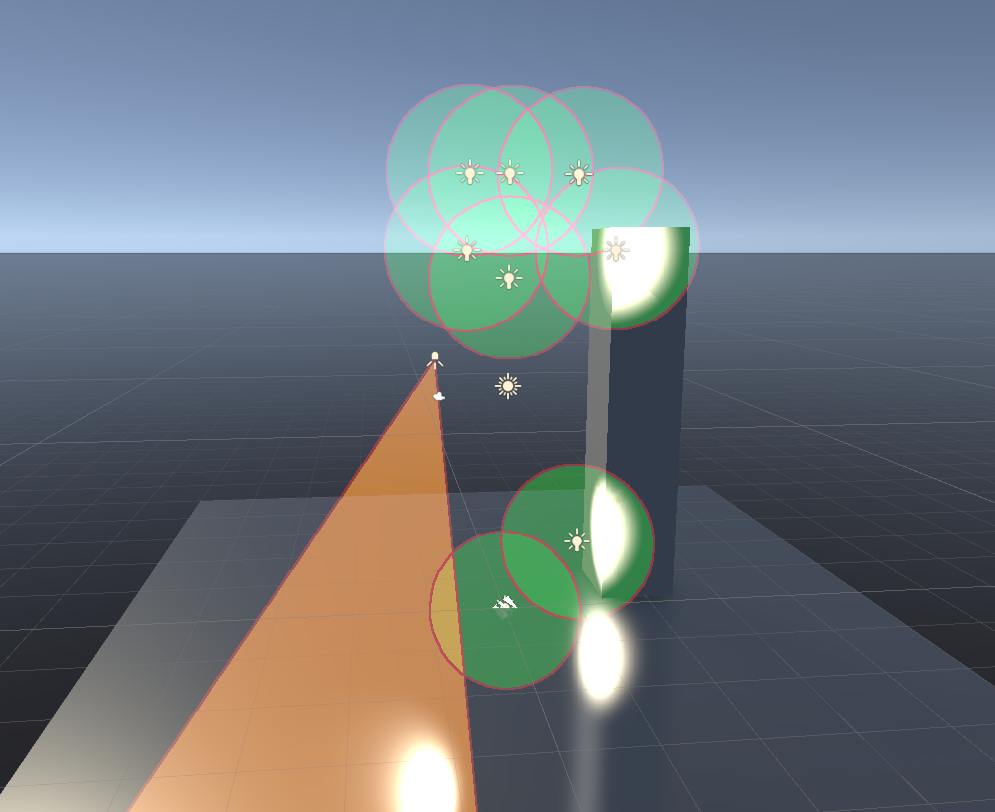
Example of display of light volumes, here one spot light and several point lights.
Example of display of light volumes, here one spot light and several point lights.
New shader and Shader Graph support
New shader and Shader Graph support
HDRP now supports Shader Graph, which will become the main solution for future development. The Lit master node is available as a Shader Graph version, and as a built-in shader version (Lit, LayeredLit, TerrainLit). All other shaders are available only as Shader Graph versions. Future shaders will also be built using Shader Graph.
HDRP now supports Shader Graph, which will become the main solution for future development. The Lit master node is available as a Shader Graph version, and as a built-in shader version (Lit, LayeredLit, TerrainLit). All other shaders are available only as Shader Graph versions. Future shaders will also be built using Shader Graph.
The PBR master node is based on the Lit shader. It uses a restricted set of features, which it shares with LWRP, so you can author cross-pipeline assets. 2018.3 adds support for decals and light layering to the PBR master node.
The PBR master node is based on the Lit shader. It uses a restricted set of features, which it shares with LWRP, so you can author cross-pipeline assets. 2018.3 adds support for decals and light layering to the PBR master node.
The Lit shader is now available in Shader Graph. This shader unlocks the full feature set, including coat-mask, iridescence, translucency, subsurface scattering, and anisotropic. However, the surface gradient for accurate normal blending is not yet supported. Also, tessellation is still not supported in this version of Shader Graph.
The Lit shader is now available in Shader Graph. This shader unlocks the full feature set, including coat-mask, iridescence, translucency, subsurface scattering, and anisotropic . However, the surface gradient for accurate normal blending is not yet supported. Also, tessellation is still not supported in this version of Shader Graph.
Note: The wind effect has been disabled from the built-in Lit shader, and enabled in Shader Graph. If you want to simulate wind or any other vertex animation, you must use Shader Graph.
Note: The wind effect has been disabled from the built-in Lit shader, and enabled in Shader Graph. If you want to simulate wind or any other vertex animation, you must use Shader Graph.
We have also added a Fabric shader to Shader Graph. With it, you can author fabric material with a soft look, and fake the scattering of fibers. The Fabric master node supports two lighting models: CottonWool and Silk. Use these to create a wide variety of cloth. The implementation of CottonWool is based on recent research from Sony Pictures Imageworks, presented at Siggraph 2017. The Silk version is based on GGX anisotropic.
We have also added a Fabric shader to Shader Graph. With it, you can author fabric material with a soft look, and fake the scattering of fibers. The Fabric master node supports two lighting models: CottonWool and Silk. Use these to create a wide variety of cloth. The implementation of CottonWool is based on recent research from Sony Pictures Imageworks , presented at Siggraph 2017. The Silk version is based on GGX anisotropic.
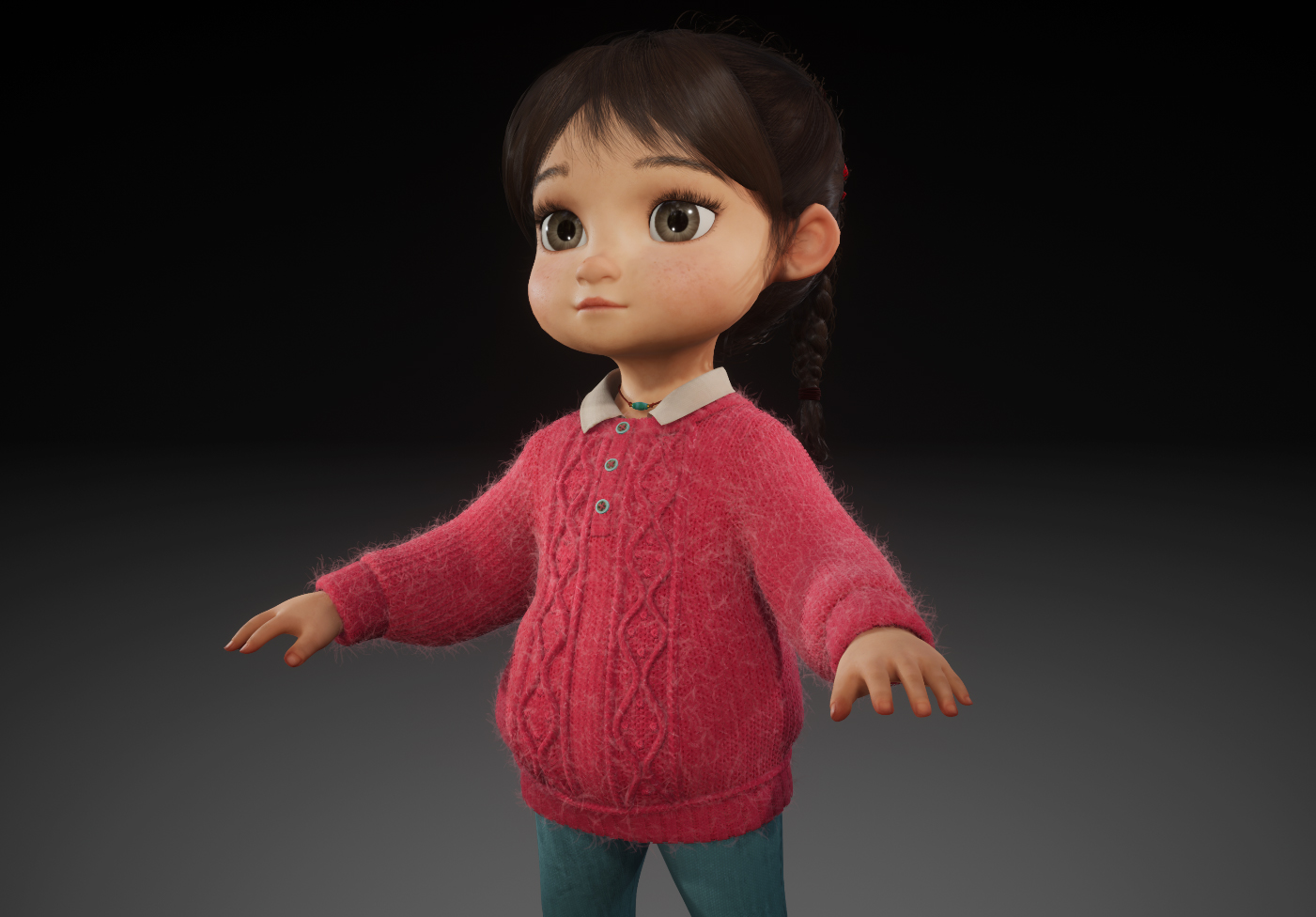
The wear of the girl is using the fabric model. This mesh is using a composition of normal map that defines the pattern of the wear done in Shader Graph.
The wear of the girl is using the fabric model. This mesh is using a composition of normal map that defines the pattern of the wear done in Shader Graph.
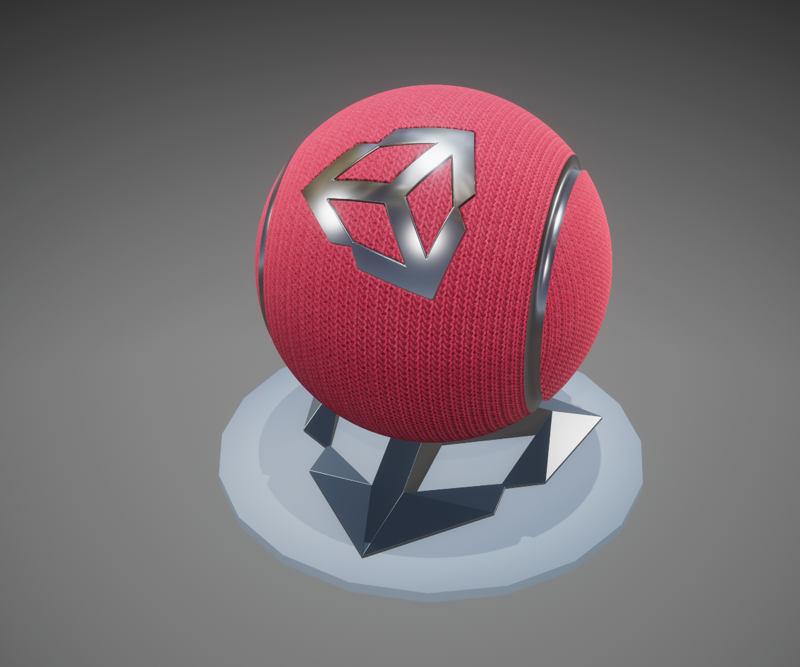
Fabric model show on Unity sphere.
Fabric model show on Unity sphere.
The StackLit shader has been added to Shader Graph. Note: The built-in StackLit was removed from package 4.4.0 in favor of the Shader Graph version, which we introduced in the same package.
The StackLit shader has been added to Shader Graph. Note: The built-in StackLit was removed from package 4.4.0 in favor of the Shader Graph version, which we introduced in the same package.
The StackLit shader is an improvement over the Lit shader, which focuses more on quality than on performance, making it unsuitable for some games. Compared to Lit, StackLit more accurately handles the coating of surfaces. This is thanks to the research of Laurent Belcour from Unity Labs, which we presented at Siggraph 2018: “Efficient Rendering of Layered Materials Using an Atomic Decomposition with Statistical Operators.” It has a new parametrization to control the highlight: hazy parametrization. This was introduced in the paper: “A Composite BRDF Model for Hazy Gloss.”
The StackLit shader is an improvement over the Lit shader, which focuses more on quality than on performance, making it unsuitable for some games. Compared to Lit, StackLit more accurately handles the coating of surfaces. This is thanks to the research of Laurent Belcour from Unity Labs, which we presented at Siggraph 2018: “ Efficient Rendering of Layered Materials Using an Atomic Decomposition with Statistical Operators .” It has a new parametrization to control the highlight: hazy parametrization. This was introduced in the paper: “A Composite BRDF Model for Hazy Gloss.”
Lastly, this shader allows you to mix all features together without restriction. For example, you can have anisotropy with subsurface scattering, iridescence, and hazy parametrization.
Lastly, this shader allows you to mix all features together without restriction. For example, you can have anisotropy with subsurface scattering, iridescence, and hazy parametrization.

Furthermore, this version fixes a lot of bugs reported by our awesome community. The complete list of fixes, changes, and additions is available in the changelog on GitHub.
Furthermore, this version fixes a lot of bugs reported by our awesome community. The complete list of fixes, changes, and additions is available in the changelog on GitHub .
Improvements to video and removal of the legacy MovieTexture feature (Improvements to video and removal of the legacy MovieTexture feature)
Unity 2018.3 includes faster texture updates. This helps eliminate all the time taken on the main thread for doing texture upload and consumes less time in the graphics thread. Platforms such as HoloLens and slower Windows versions should especially benefit from this.
Unity 2018.3 includes faster texture updates. This helps eliminate all the time taken on the main thread for doing texture upload and consumes less time in the graphics thread. Platforms such as HoloLens and slower Windows versions should especially benefit from this.
We also added audio resampling, which enables users to change the speed of videos and have the audio change speed accordingly and stay in sync.
We also added audio resampling, which enables users to change the speed of videos and have the audio change speed accordingly and stay in sync.
In Unity 2018.2, we began the process of removing the legacy MovieTexture feature. If your project still uses MovieTexture, you should upgrade it to use the VideoPlayer, introduced in Unity 5.6. Since the VideoPlayer is fundamentally different from the MovieTexture approach, it may not be possible to provide an automatic upgrader tool. Learn more about the MovieTexture deprecation in our forum.
In Unity 2018.2, we began the process of removing the legacy MovieTexture feature. If your project still uses MovieTexture, you should upgrade it to use the VideoPlayer, introduced in Unity 5.6. Since the VideoPlayer is fundamentally different from the MovieTexture approach, it may not be possible to provide an automatic upgrader tool. Learn more about the MovieTexture deprecation in our forum .
Services (Services)
Cloud Diagnostics (previously Performance Reporting) (Cloud Diagnostics (previously Performance Reporting))
There are many new features and updates for Performance Reporting. So many in fact that we’ve renamed the service “Cloud Diagnostics” to better capture the scope of what it can and will do. Most important of all, these features are no longer limited to Unity Plus and Pro users! All users can access them. To learn more, check out this blog post.
There are many new features and updates for Performance Reporting. So many in fact that we've renamed the service “Cloud Diagnostics” to better capture the scope of what it can and will do. Most important of all, these features are no longer limited to Unity Plus and Pro users! All users can access them. To learn more, check out this blog post .
First, reports sent by games built using 2018.3 can now contain debug logs and custom metadata. Both of these features will help you better understand the scenario that led up to the report being filed.
First, reports sent by games built using 2018.3 can now contain debug logs and custom metadata. Both of these features will help you better understand the scenario that led up to the report being filed.
We’ve also introduced a completely new report type. While previous report types – crash, exceptions – were machine generated, User Reports let you collect feedback directly from your end users. They can send you useful information such as screenshots, saved games, videos or anything else you find useful to help improve your user experience. All of these reports are collected and aggregated in Unity’s Developer Dashboard.
We've also introduced a completely new report type. While previous report types – crash, exceptions – were machine generated, User Reports let you collect feedback directly from your end users. They can send you useful information such as screenshots, saved games, videos or anything else you find useful to help improve your user experience. All of these reports are collected and aggregated in Unity's Developer Dashboard.

The Developer Dashboard consolidates user-generated screenshots and feedback for you to review.
The Developer Dashboard consolidates user-generated screenshots and feedback for you to review.
Connected Games (Connected Games)
With UNET being deprecated, we’ve begun to provide access to new multiplayer-enabling features. A new network transport layer is available in an open alpha. It’s lean and built for an ECS-style implementation for future Unity versions. Furthermore, two key multiplayer services are currently in closed alpha. First, Game Hosting Servers let you leverage a cloud-powered fleet running headless instances of your game. Second, Matchmaking lets you not only group your players together but works with Game Hosting Servers so you can automatically ramp your cloud utilization up and down with player demand in real-time.
With UNET being deprecated , we've begun to provide access to new multiplayer-enabling features. A new network transport layer is available in an open alpha. It's lean and built for an ECS-style implementation for future Unity versions. Furthermore, two key multiplayer services are currently in closed alpha. First, Game Hosting Servers let you leverage a cloud-powered fleet running headless instances of your game. Second, Matchmaking lets you not only group your players together but works with Game Hosting Servers so you can automatically ramp your cloud utilization up and down with player demand in real-time.
For access to connected games features in open alpha, check out the GitHub repository. Interested in closed alpha access? Apply now.
For access to connected games features in open alpha, check out the GitHub repository . Interested in closed alpha access? Apply now.
Project Tiny Preview Package is Here! (Project Tiny Preview Package is Here!)
Project Tiny is a new modular Unity runtime and editor mode to build games and experiences that can load instantly and without install. Project Tiny gives developers the tools they need to quickly create quality 2D Instant Games and Playable Ads that are small in size and have a blazing-fast startup on a wide range of mobile devices.
Project Tiny is a new modular Unity runtime and editor mode to build games and experiences that can load instantly and without install. Project Tiny gives developers the tools they need to quickly create quality 2D Instant Games and Playable Ads that are small in size and have a blazing-fast startup on a wide range of mobile devices.
Project Tiny is delivered as a package called “Tiny Mode.” To install it, open the 2018.3 Package Manager, enable Preview Packages, and install Tiny Mode. It can be used with all Unity licenses – Personal, Plus, and Pro. You can find the Tiny User Manual, API documentation and sample projects in the Preview package download. More information, plus training videos, can be found on the Solutions page and in the Project Tiny Preview blog post.
Project Tiny is delivered as a package called “Tiny Mode.” To install it, open the 2018.3 Package Manager, enable Preview Packages, and install Tiny Mode. It can be used with all Unity licenses – Personal, Plus, and Pro. You can find the Tiny User Manual, API documentation and sample projects in the Preview package download. More information, plus training videos, can be found on the Solutions page and in the Project Tiny Preview blog post .
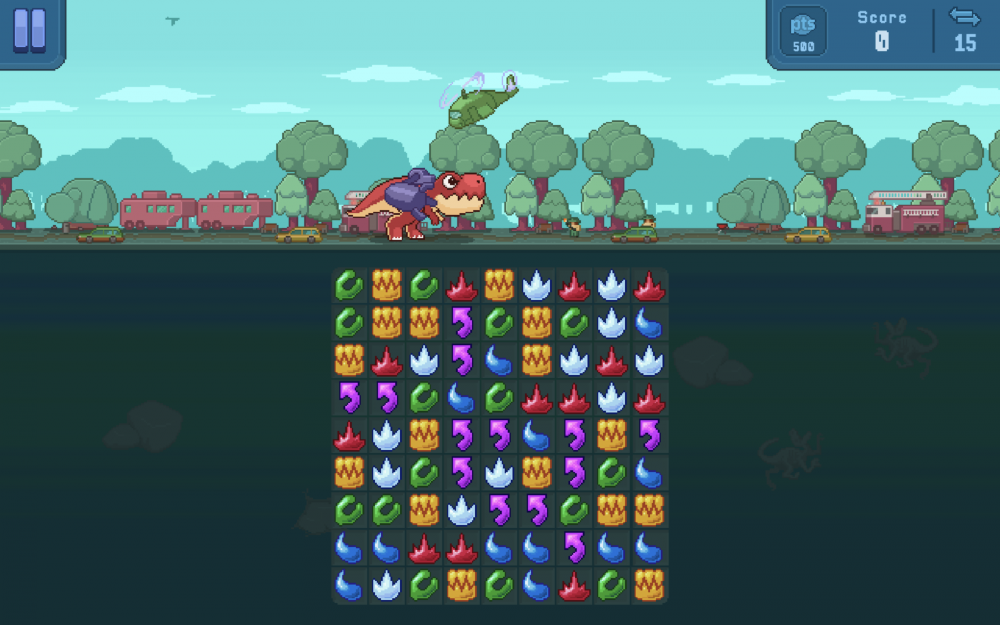
Visit the forums for more information or to provide feedback. We look forward to hearing what you think!
Visit the forums for more information or to provide feedback. We look forward to hearing what you think!
FPS Sample (FPS Sample)
At Unite LA in October 2018, we announced the first release of the FPS Sample project, a multiplayer first-person shooter game.
At Unite LA in October 2018, we announced the first release of the FPS Sample project, a multiplayer first-person shooter game.
A team of just six experienced game developers at Unity used the latest bleeding-edge features in 2018.3 on this large-scale project which enabled them to provide R&D teams with insightful feedback during the beta phase.
A team of just six experienced game developers at Unity used the latest bleeding-edge features in 2018.3 on this large-scale project which enabled them to provide R&D teams with insightful feedback during the beta phase.
Following one of the team’s core principles, the project runs on what is often referred to as “vanilla” Unity. In other words, it doesn’t require any custom builds or Asset Store packages. The game sample project includes everything from source code and artwork assets to sound effects built on the latest version of Unity. The FPS Sample provides a great opportunity to check out some of the 2018.3 features in action. You are, of course, also welcome to use the full project as a framework or starting point for your own online shooter game. What’s more, all the assets are available under the Unity Companion license, which means you can even use it for Unity-based commercial projects.
Following one of the team's core principles, the project runs on what is often referred to as “vanilla” Unity. In other words, it doesn't require any custom builds or Asset Store packages. The game sample project includes everything from source code and artwork assets to sound effects built on the latest version of Unity. The FPS Sample provides a great opportunity to check out some of the 2018.3 features in action. You are, of course, also welcome to use the full project as a framework or starting point for your own online shooter game. What's more, all the assets are available under the Unity Companion license , which means you can even use it for Unity-based commercial projects.
Watch Lead Technical Artist, Martin Kümmel Vestergaard and Lead Programmer, Peter Andreasen explain the core principles of the FPS Sample and how the project benefits both Unity R&D and Unity users:
Watch Lead Technical Artist, Martin Kümmel Vestergaard and Lead Programmer, Peter Andreasen explain the core principles of the FPS Sample and how the project benefits both Unity R&D and Unity users:
The team plans to continuously update the FPS Sample to run on the most recent versions and to adopt the latest features, which will help us gather useful feedback.
The team plans to continuously update the FPS Sample to run on the most recent versions and to adopt the latest features, which will help us gather useful feedback.
To get the project and see the 2018.3 features in action, go to the project page on GitHub for instructions on how to download and run the project.
To get the project and see the 2018.3 features in action, go to the project page on GitHub for instructions on how to download and run the project.
You can learn more about the FPS Sample project in this blog post or on the FPS Sample webpage. If you have questions or suggestions, or are experiencing problems, please visit the FPS Sample forum
You can learn more about the FPS Sample project in this blog post or on the FPS Sample webpage. If you have questions or suggestions, or are experiencing problems, please visit the FPS Sample forum
Release notes (Release notes)
The full release includes 45 features, 250 changes and improvements, and 1915 fixes. To find all the details, as always, refer to the release notes for the full list.
The full release includes 45 features, 250 changes and improvements, and 1915 fixes. To find all the details, as always, refer to the release notes for the full list.
TECH and Long-Term Support (LTS) streams (TECH and Long-Term Support (LTS) streams)
As explained in this blog post, and previously announced at GDC, Unity releases comprise a TECH stream and a Long-Term Support stream (LTS).
As explained in this blog post, and previously announced at GDC, Unity releases comprise a TECH stream and a Long-Term Support stream (LTS) .
The TECH stream, which includes all the latest features, has three major releases a year. This year’s TECH streams are versions 2018.1, 2018.2 and 2018.3, each of which adds new features and functionality.
The TECH stream, which includes all the latest features, has three major releases a year. This year's TECH streams are versions 2018.1, 2018.2 and 2018.3, each of which adds new features and functionality.
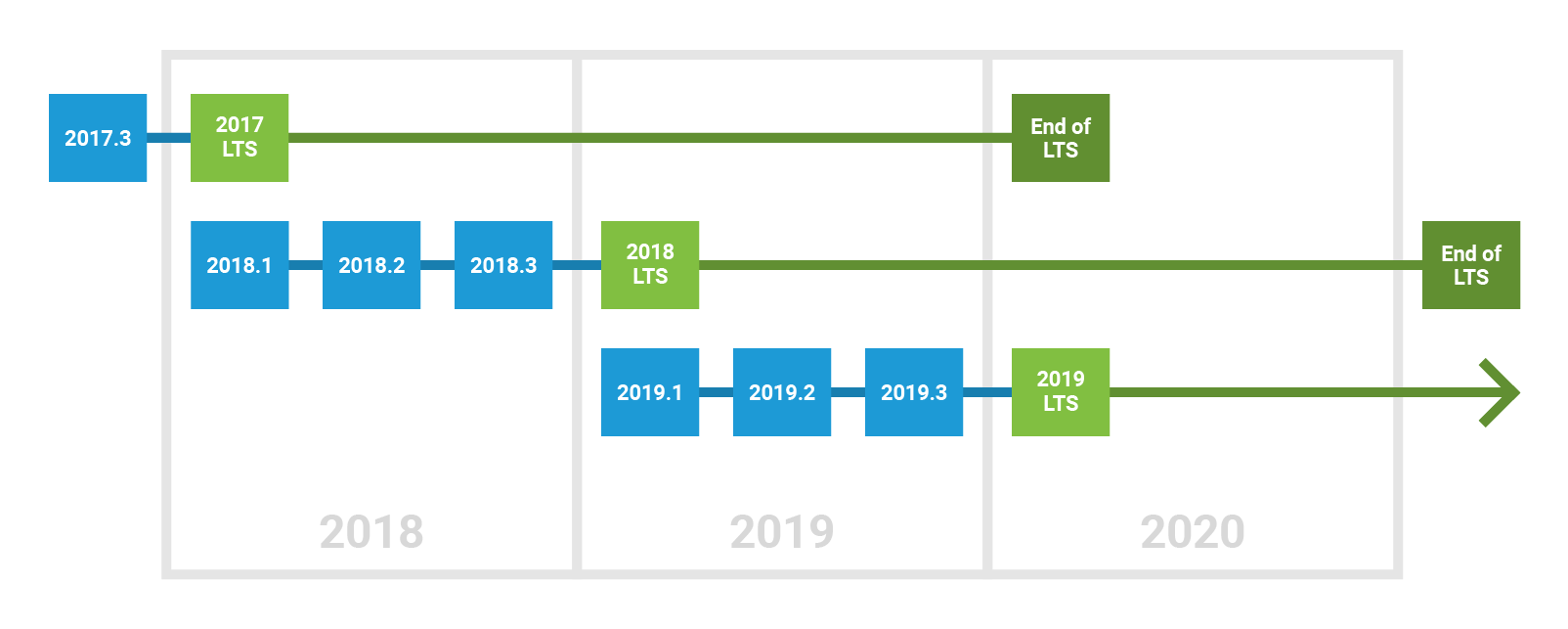
2018.3 is the last in the 2018.x TECH stream cycle, and it will become the LTS stream with a new version number (2018.4) when the new TECH stream begins with 2019.1. This marks the point at which the two-year support schedule begins.
2018.3 is the last in the 2018.x TECH stream cycle, and it will become the LTS stream with a new version number (2018.4) when the new TECH stream begins with 2019.1. This marks the point at which the two-year support schedule begins.
Unlike the TECH stream, the LTS stream will not have any new features, API changes or improvements. Instead, it will address crashes, regressions, and issues that affect the wider community, console SDK/XDKs, or any major changes that would prevent a large number of developers from shipping their games.
Unlike the TECH stream, the LTS stream will not have any new features, API changes or improvements. Instead, it will address crashes, regressions, and issues that affect the wider community, console SDK/XDKs, or any major changes that would prevent a large number of developers from shipping their games.
Whereas the TECH stream will receive a weekly release with bug fixes, the LTS stream will receive regular bug fixes every other week. The LTS stream is thus for those of you who wish to continue to develop and ship your games/content on a stable version for an extended period. The TECH stream is for anyone who wants to use the latest features and those who want to be up to date with the latest Unity offering.
Whereas the TECH stream will receive a weekly release with bug fixes, the LTS stream will receive regular bug fixes every other week. The LTS stream is thus for those of you who wish to continue to develop and ship your games/content on a stable version for an extended period. The TECH stream is for anyone who wants to use the latest features and those who want to be up to date with the latest Unity offering.
Join us in the 2019.1 alpha (Join us in the 2019.1 alpha)
If you are curious to see what’s coming next, Unity 2019.1a is the first Unity alpha available to everyone.
If you are curious to see what's coming next, Unity 2019.1a is the first Unity alpha available to everyone.
Although there is a higher probability that you will encounter bugs than in a beta version, as an alpha user, you will get access to new features sooner, be able to test the compatibility of the new version with your projects, provide feedback, and get problems in Unity fixed sooner.
Although there is a higher probability that you will encounter bugs than in a beta version, as an alpha user, you will get access to new features sooner, be able to test the compatibility of the new version with your projects, provide feedback, and get problems in Unity fixed sooner.
As an alpha user, you will also get to connect with our experts, share insights with experienced members of the Unity community, and influence the future of Unity with surveys, feedback and the chance to be invited to user roundtables.
As an alpha user, you will also get to connect with our experts, share insights with experienced members of the Unity community, and influence the future of Unity with surveys, feedback and the chance to be invited to user roundtables.
How to get started
How to get started
To begin, download the latest prerelease version of 2019.1. New incremental alpha iterations and features will be published once a week until all major content scheduled for this version is included and the transition to beta is made.
To begin, download the latest prerelease version of 2019.1 . New incremental alpha iterations and features will be published once a week until all major content scheduled for this version is included and the transition to beta is made.
The information in this guide to being an effective beta tester applies to alpha users as well, and it gives you an overview of what to consider. If you would like to receive occasional emails with news, updates, tips and tricks, please sign up below.
The information in this guide to being an effective beta tester applies to alpha users as well, and it gives you an overview of what to consider. If you would like to receive occasional emails with news, updates, tips and tricks, please sign up below.
翻译自: https://blogs.unity3d.com/2018/12/13/introducing-unity-2018-3/
unity2018.4.3


